Archive for category Past issues
A Pearl of Wisdom on Interpersonal Relationships from Ouvaiyaar, the Grandmotherly Tamil Poet
Posted by admin in January 2019, Past issues on January 24, 2019
Ouvvaiyaar is a legendary— even mythical — poet in Tamil literature. With the name meaning in Tamil “The respectable Old Lady,†one can imagine the exalted place her name occupies among Tamils, scholars and commoners alike. Literary historians believe that more than one person went by the name. For example, there was one Ouvvaiyaar in the Sangam Period (2nd century BC to 2nd century AD), and one in the 10th century.
They conclude this after carefully analyzing the phrases and vocabulary used in the literary works attributed to the Poetess Ouvvaiyaar.
From her literary works, we learn that he was a Saivite, grandmotherly, austere mendicant, full of wisdom on the way of the world. Her message transcends time, place and cultures.
Here is one of her pearls of wisdom, on what we call today interpersonal relationships today, first in Tamil, in the meter of Vennbaa. :

Here is the non-literary translation:
Rice paddy is threshed to get rice grains. The husk is discarded.
Without the husk intact in the paddy seed, though, it never can germinate.
No matter how intelligent, strong and capable a person is,
Without critical subordinate help, one accomplishes nothing.
Here is a great lesson on interpersonal relationships for ambitious and aggressive MBA students and other graduating seniors who will be starting their careers making big bucks while managing other people’s resources and assets in corporations.
This is also a good advice for doctors, engineers, lawyers, managers and business owners, who are in great haste trying to climb their career ladders and amass wealth, not paying attention to how they trample on their colleagues and subordinates.
Till even 70 years ago, Tamil alphabets in schools were taught using Ouvvaiyaar’s works, Aathi-choodi and Kondrai-vendan. In these, each alphabet was vocalized — like a for Apple, b for biscuits, c for cat in English – but with this major difference: Each Tamil alphabet – like a aa, e, ee, u uu… – was elaborated with an advice starting with that alphabet, that conveyed codes of conduct, such as “Be 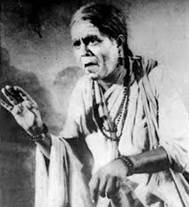 charitableâ€, “Be helpfulâ€, “Control your temperâ€,  “Don’t give up efforts†… …  In today’s teaching of Tamil in elementary schools, these are completely gone.
charitableâ€, “Be helpfulâ€, “Control your temperâ€,  “Don’t give up efforts†… …  In today’s teaching of Tamil in elementary schools, these are completely gone.
She is so popular among the Tamils that decades ago they made a popular play on Ouvvaiyaar, with T K Shanmugam (see the picture on above), a male actor, playing the role of Ouvvaiyaar. A black-and white film was made with the famous K B Sundarambal playing the role of Ouvvaiyaar.
— By K  S  Venkataraman
Home:
Celebrate Every New Moment as a Providential Gift, Not Just January 1… …
Posted by admin in January 2019, Past issues on January 24, 2019
Natyakriya Celebrates Ten Years
Posted by admin in January 2019, Past issues on January 19, 2019
By Srujana Kanjula, Wexford, PAÂ Â Â Â Â Â Â Â Â srubru@rediffmail.com
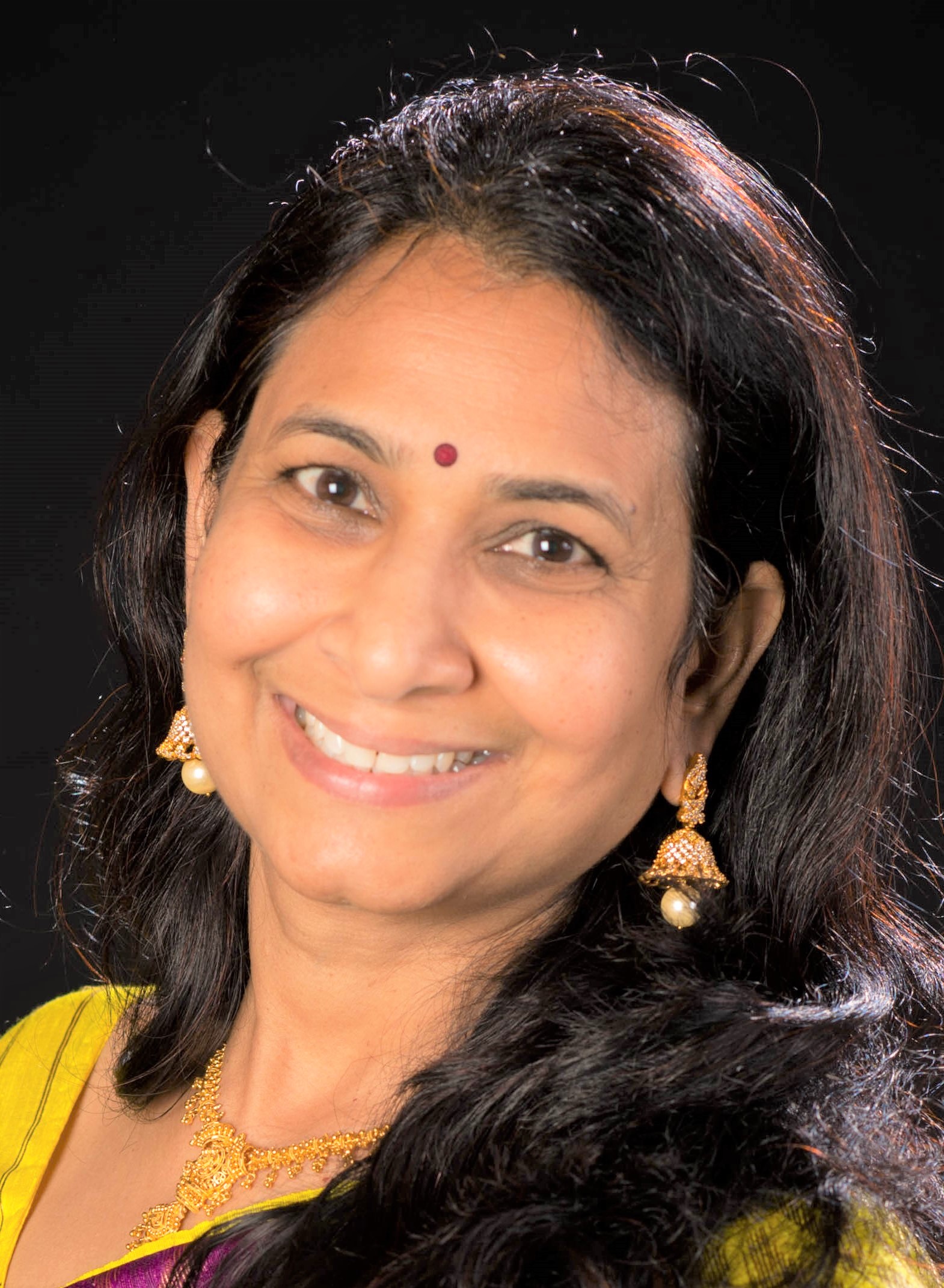 Editor’s Note: Srujana (picture on the side) was born in Tirupathi and had her schooling at Anantapur, in Andhra Pradesh. After her MA in Political Science from Hyderabad Central University, she completed her MPhil and PhD from Jawaharlal Nehru University (JNU), New Delhi. She teaches political science and sociology at the Community College of Allegheny County (CCAC) at North Campus, and lives in Wexford, PA.
Editor’s Note: Srujana (picture on the side) was born in Tirupathi and had her schooling at Anantapur, in Andhra Pradesh. After her MA in Political Science from Hyderabad Central University, she completed her MPhil and PhD from Jawaharlal Nehru University (JNU), New Delhi. She teaches political science and sociology at the Community College of Allegheny County (CCAC) at North Campus, and lives in Wexford, PA.
The founder of the dance school Natyakriya, Shobhitha Ravi (picture below), with fifteen of  her students, presented the dance program, Sri Vidya Shakti, on October 6, 2018, at North Hills Middle School, celebrating ten years of teaching Bharatanatyam. The theme of the production Sri (wealth), Vidya (knowledge) and Shakti (strength) was in praise of Devi, the universal mother in Hinduism. The program coincided with the Navaratri festival in which Hindus celebrate Devi in the form of Lakshmi (Sri), Saraswati (Vidya) and Parvathi (Shakti).
her students, presented the dance program, Sri Vidya Shakti, on October 6, 2018, at North Hills Middle School, celebrating ten years of teaching Bharatanatyam. The theme of the production Sri (wealth), Vidya (knowledge) and Shakti (strength) was in praise of Devi, the universal mother in Hinduism. The program coincided with the Navaratri festival in which Hindus celebrate Devi in the form of Lakshmi (Sri), Saraswati (Vidya) and Parvathi (Shakti).
The program was divided into three sections, each focusing on one theme with the dancers in traditional bright costumes performing three items in each section. The young dancers were good with abhinaya, a coordinated combination of movements of the legs and footwork and hand gestures to rhythmic music and facial expressions, all to convey stories.
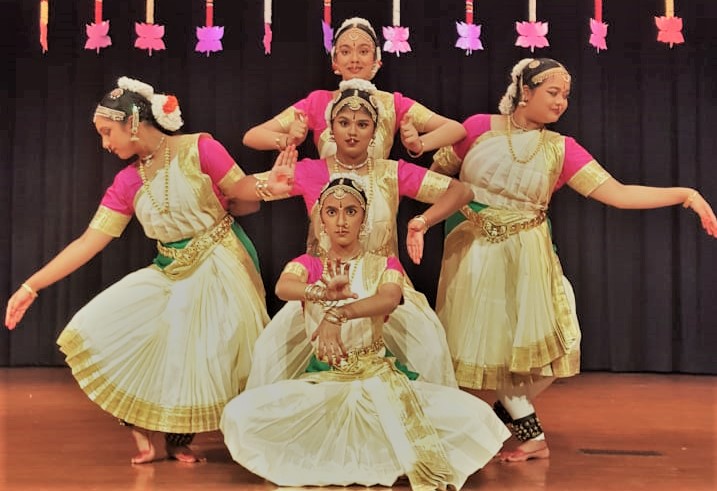
Akshara Murali, Bhavana Kolla, Jothika Gorur, Nanditha Ganesan, and Malini Harinath.
It was a ticketed event, with all the proceeds benefiting EKAM USA Foundation, a non-profitorganization committed to providing healthcare to needy babies and mothers in India to reduce the mortality of mothers & infants at child birth.
The program was a success with good attendance helping a social cause. Shobhitha’s solo dance was impressive and her students were energetic, enthusiastic, and talented. Their hard work and love for dance was evident throughout. The master of ceremonies, Sandhya Rao, impressed the audience, describing the dance pieces and relating them meaningfully to the nine-day Navaratri celebrations. Carol Schneider, the World Languages teacher at Shady Side Academy Senior School aptly remarked, “The dances were stunningly beautiful and exquisitely choreographed. The movements, the music, and bright costumes combined to make the experience enchanting and enriching.â€
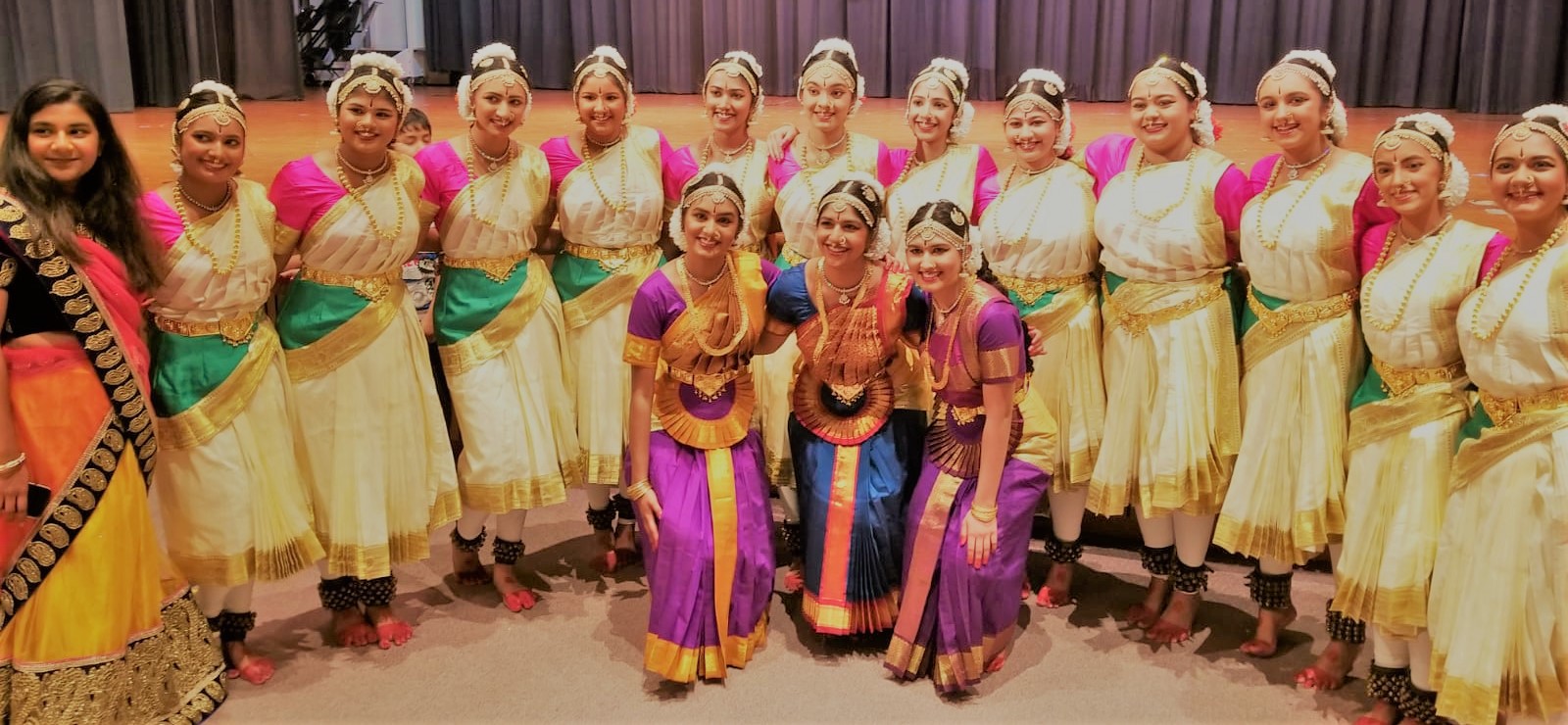
L to R Top: Somya Thakur, Sherin Puthenpurayil, Bhavana Kolla, Mitali Belambe, Meghana Vemulapalli, Sruthy Miriyala, Malini Harinath, Sanjana Harish, Kavya Balakumar, Nanditha Ganesan, Akshara Murali, Jothika Gorur, Anagha Arunkumar. Bottom: Keerthana Samanthapudi, Harsha Mikkilineni, Inu Miriyala.
Natyakriya, founded in 2008, strives to preserve and spread Indian art and culture here. From a small base of eighteen students, the school now has over 100 students. Over the years, ten students have completed their arangetram under Shobhitha, a disciple of Natyakalavathi Jaya Mani, who trained Shobhitha in the Kancheepuram Ellappa Pillai tradition.
With a passion for dance and patience, Shobhitha mentors and inspires her students. We wish her well for continued success in the years ahead in teaching Bharatanatyam and touching the lives of many children and parents in such a profound manner. ♠
Home:
The ‘Burgh’s Brand New Organization for Seniors
Posted by admin in January 2019, Past issues on January 19, 2019
By Arun D. Jatkar, Monroeville, PAÂ Â Â Â Â Â Â Â Â Â ajmarathi@yahoo.com
Founded by Pittsburgh’s senior citizens to serve the interests of Pittsburgh’s senior citizens and open to all senior citizens regardless of creed, color and country of origin, here is the United Seniors Association of Pittsburgh (or USAP for short).
USAP was founded in December 2017 and registered as a non-profit organization in the Commonwealth of Pennsylvania. It has also received approval as a tax-exempt 501(c)(3) charitable organization from the U.S. Internal Revenue Service.
USAP’s mission statement reads:
To promote healthy aging through education, participation and social support, and thus, dignity, independence and longevity of its members in their senior years; and provide a forum that would encourage able seniors to help fellow seniors in need, with goal to minimize their dependence on society.
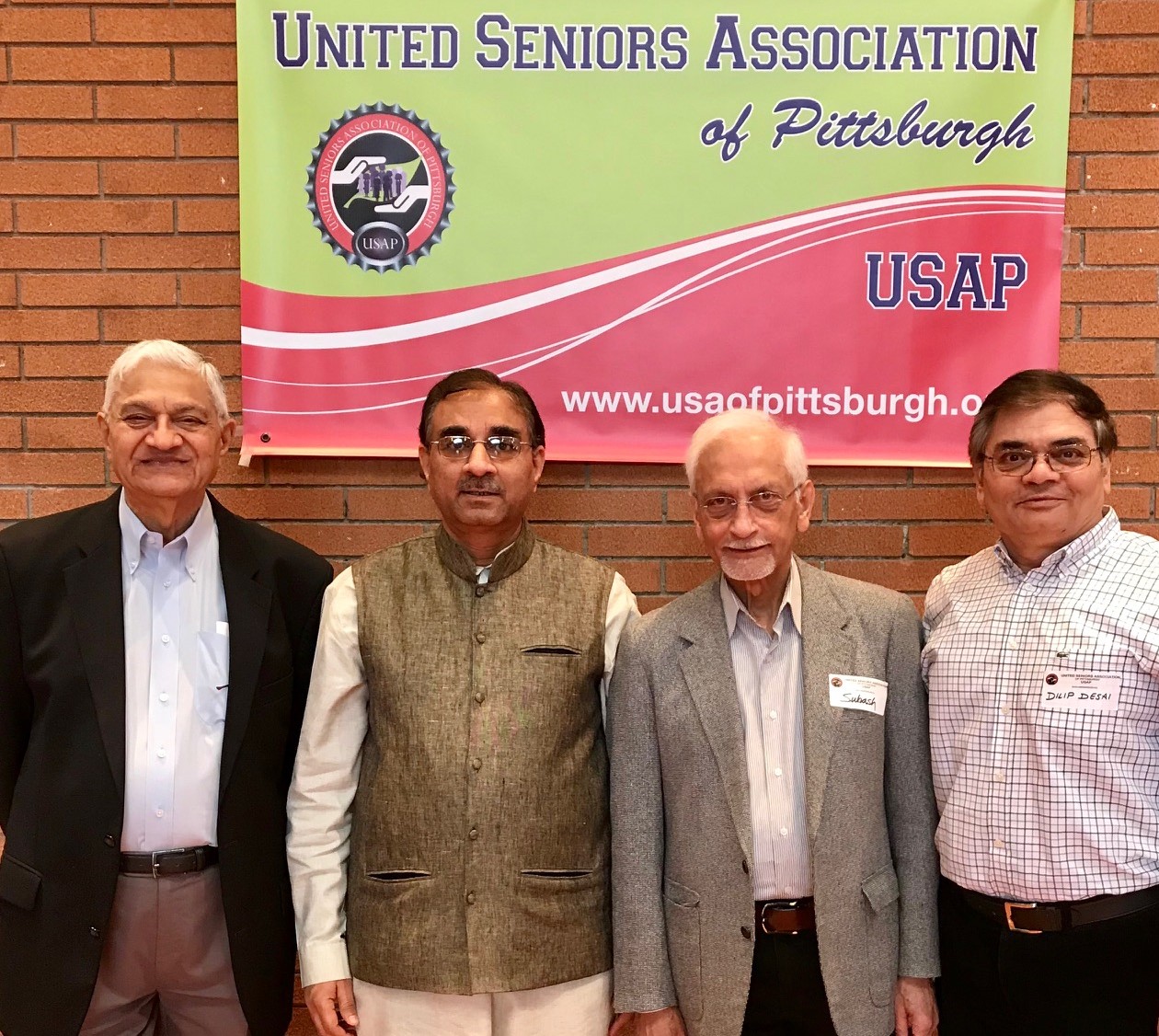
Current office holders L to R: Rajnikant Popat, Chetan Patel, Subash Ahuja, and Dilip Desai.
Two hundred and forty-two senior citizens of Pittsburgh have already become members of this rapidly growing organization. This includes 31 life-time charter members.
USAP members are vibrant professionals from all walks of life — doctors, engineers, computer specialists, teachers, businessmen, entrepreneurs — with wide interests and passions on diverse topics.
During 2018, its first year of operation, USAP organized fourteen well-attended, well-received informative and entertaining events. These included, among others, informative talks by professionals on healthy aging and financial and social wellbeing. Topics included :
- Yoga & meditation, physical fitness,
- Ayurvedic approach to healthy eating and living,
- New tax laws affecting senior citizens,
- Health insurance, protection of personal identity,
- A music gala, a bowling bash, introduction to bridge and other card games, a golf outing, and
- A three-week organized tour of eastern Europe!
One might think that all this must amount to a big fat membership fee that a middle-class senior living off his or her limited life savings and Social Security income can only dream of. Nothing could be further from the truth! Now get this: It is only $30 per person for 2019. This number was at the insistence of the all members because refreshments and snacks are served free of charge at these events. Beverages like tea and coffee are always on the house at all events. And one could go for Charter Membership by paying only $ 500 per person.
Organizationally, four officers run USAP: Mr. Chetan Patel (President), Mr. Dilip Desai (Vice President), Dr. Subash Ahuja (Secretary) and Dr. Rajnikant Popat (Treasurer), with these committee chairs:
Mr. Girish Thakar (Life and Finance Planning), Dr. Chetan Ladani (Health and Fitness), Dr. Ved Kaushik (Hobby and Sports), Chetan Patel (Cultural, Social and Humanitarian), Dr. Kiran Bakshi (Tours and Travel), Mr. Jayant Mirani (Membership) and Dr. Juginder Luthra (Social Media and Publications).
When I asked Dr. Ahuja, the secretary of USAP, what he would like to tell the as-yet-uncommitted seniors of Pittsburgh, his face lit up and without any hesitation he said, “Join USAP, ASAP!”
More information is available at www.usaofpittsburgh.org.  ♠
Home:
PIC-5K Raises $58-k in Fun-filled Annual Walkathon Event Last Fall
Posted by admin in January 2019, Past issues on January 19, 2019
Suresh C Ramanathan, Volunteer for the PIC-5K Event
 Five years ago, the Pittsburgh Indian Community and Friends (PICAF) Nonprofit was established to bring the entire community together across all languages, religions and social and cultural groups around a single event, the PIC-5K Walk/Run. Its purpose was simple and
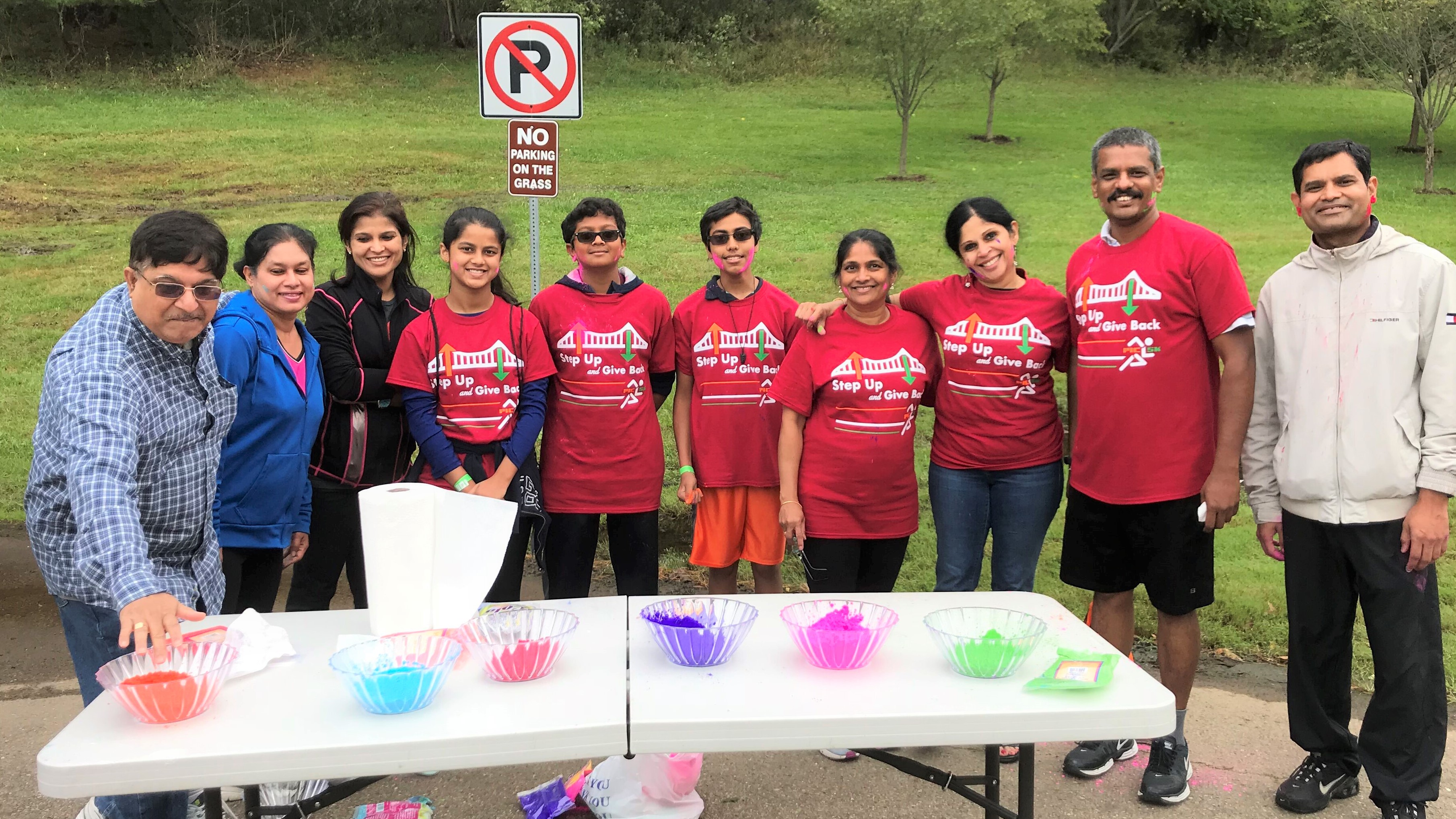
Some of the volunteers in the PIC-5k Event.
straightforward: to try to make a huge impact in the lives of people in the region where we live, work, study, and raise our families through a fun-loving fundraising event in the fall. All the money raised through donations in this annual event goes to nonprofits. Volunteers cover all the operational costs.
These last five years, PIC-5K has raised about $250,000, including the operational costs that are covered by volunteers who run this unique event. Thanks to the generosity of donors and the frugal approach of the organizing volunteers, this year, PIC-5K raised nearly $58,000 in the September 22 event. And the organizers will distribute the $58,000 raised in the event to various community organizations.
Great efforts go to due diligence for identifying, vetting and selecting the non-profits in the
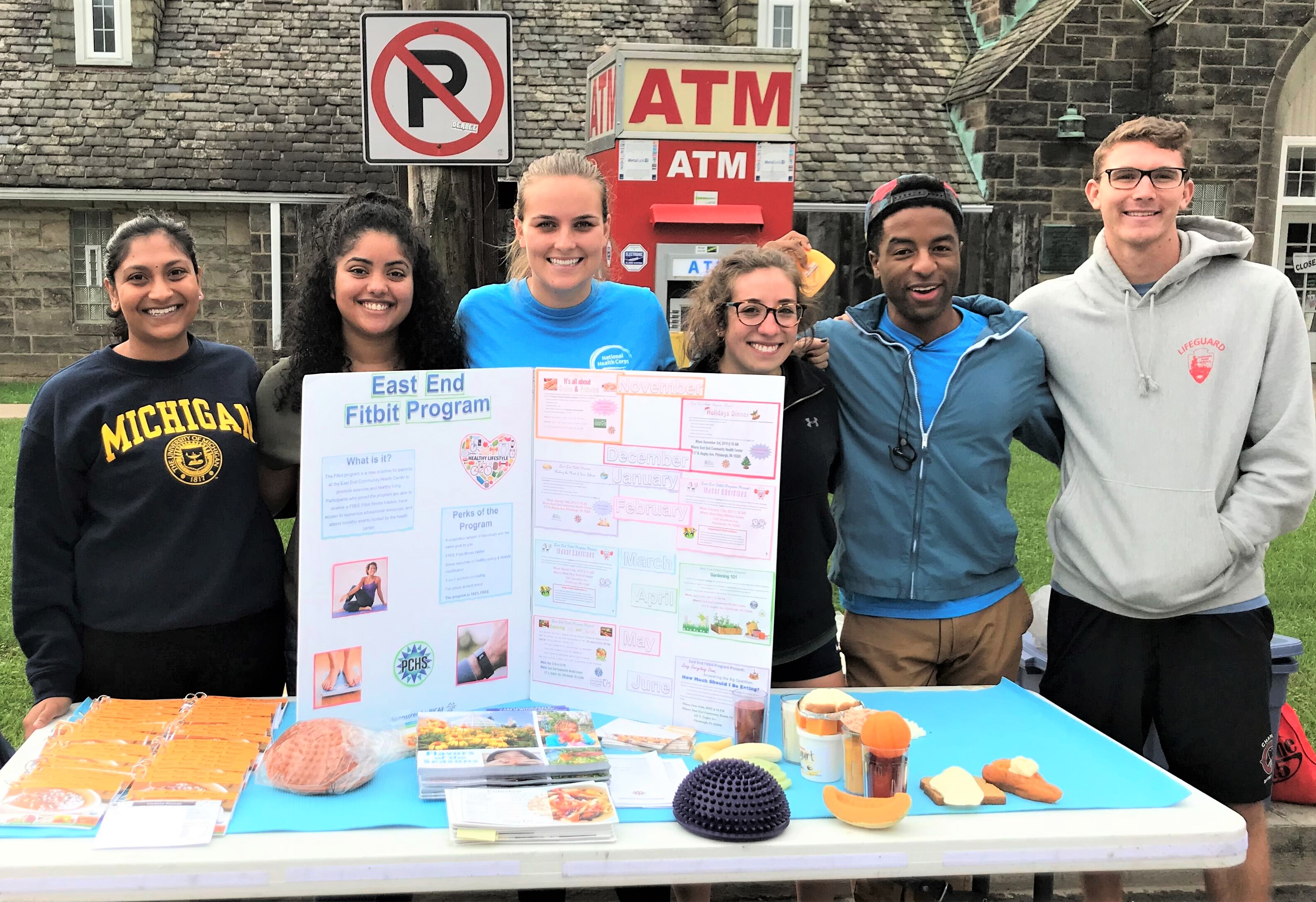
      Volunteers at the East End FitBit Program booth.
Greater Pittsburgh area mitigating homelessness, helping with healthcare and education for the needy, and emergency first responders. We request award recipients to use all the funds we donate to deliver programs to the deserving individuals in our region. We try to ensure that the recipients of our funds follow-through by requesting outcome-based reports following our funding guidelines.
You have helped us make a huge impact over the last four years and it shows! With your help we have impacted many local programs including but not limited to:
- After-school education program that helped 525 homeless children
- Nutrition program targeting low-income families
- Helping adults finish high school
- Exposing 500 underserved girls to arts and culture
- Mobile employment training to homeless people
- Setting up computers for use by the homeless
- Shoot, Don’t Shoot VR training program for 900 Police officers
- Book donations for underprivileged children.
PIC-5K’s community investments from fund raised in 2018:
- Mary’s Market Program, a stop-gap food pantry for the needy
- Home Again Program for moving homeless to their next home
- AP/EA Program to bridge the gap of textbooks for needy students
- Mother & Son Program to bring them together and make them more responsible and successful
- Additional incremental funding for Backdraft Simulator
- Books for needy children
So, PIC-5K needs you in the walkathon event, and also your material support in 2019! Next year’s PIC-5K event will be on September 14, 2019. Looking forward to seeing you there!!  ♠
Home:
Akshaya Kumar: A Pittsburgh Native Working for U.N.’s Human Rights Watch
Posted by admin in January 2019, Past issues on January 19, 2019
By Rashi Venkataraman, Washington DC       Rashi1220@gmail.com
Editor’s Note: This spring, Rashi Venkataraman, a native of Murrysville, PA talked to Akshaya Kumar, the Deputy UN Director for Human Rights Watch in Washington. A graduate from Upper St. Clair, Akshaya attended George Washington University and then earned her law degree from Columbia University. Her academic and professional work has taken her to London, Egypt, Sudan and South Sudan. Akshaya Kumar currently lives in New York City with her husband. Rashi went to Franklin Regional High School and earned her BS and MS from Carnegie Mellon University. She spent a year in Indonesia as a Fulbright Scholar. After working for the Veterans Administration for several years in different capacities, she now works for a nonprofit outfit in the healthcare-related field.
Rashi: Tell me a little bit about your current role.
Kumar: Since 2015, I’ve worked for Human Rights Watch, one of the largest human rights organizations in the world. Human Rights Watch is focused on reporting and shedding light on human rights conditions around the world. The United Nations has the power and authority to affect and address human rights in many parts of the world, and my role is focused on helping the UN do their job better.
Rashi: Since the administration change in the US in 2016, what are the biggest challenges you face doing your work in 2018?
Kumar: One of the great things about the Human Rights Watch is that our work has never solely relied on the United States as a vehicle for positive change in the world. More broadly, the United Nations is based on the principle of nations coming together from all over the world to inspire change. While there are disagreements about what that change might look like, there’s a shared sense of principles and intentions. And it’s in that shared spirit of trying to do the right thing to improve peoples’ lives that we are able to work with our counterparts at the UN on different initiatives.
Rashi: Beyond the standard accomplishments question, what is the coolest project you’ve worked on?
Akshaya: Well, the one that probably excited my family in India the most is the Op-Ed piece in the New York Times I co-authored with George Clooney and John Prendergast. It was great to shed light on the conflict in Darfur. It’s great when you can harness the power of celebrity to shed light on an important topic.
Rashi: What advice would you give young Indian-Americans growing up in Pittsburgh that might be interested in your career track?
Kumar: Pittsburgh can feel like a small town when you’re growing up and interested in international affairs. I didn’t even know a job like this existed when I grew up in Pittsburgh! There’s no reason to feel like you have to operate in a certain lane. I went to law school and got my law degree, but you don’t have to practice law if you don’t want to; there are ample opportunities to take that legal training to create your own niche. I’ve found that my law background and training has been a great foundation for doing the international justice work that is my passion.
Rashi:Â What do you miss most about Pittsburgh?
Kumar: I left Pittsburgh about fifteen years ago when I left to pursue my degree in Washington, DC. Further academic pursuits and jobs have taken me to New York, London, Egypt, Sudan, and South Sudan. When I think about growing up in Pittsburgh, I think of the tight-knit Indian community there that had so many common experiences to really bind us all together. I definitely miss the familiarity of seeing the same families at the temple during the weekend; it really fostered the sense that we were all part of a community. I’ll always feel really grateful for that and look forward to paying that forward to future generations.   ♠
Home:
My Experiment with Really, Really Cold Showers
Posted by admin in January 2019, Past issues on January 19, 2019
By Kollengode S Venkataraman      ThePatrika@aol.comÂ
Like everybody else, I have done my share of crazy things in life — like getting married, as most people have done. If that was not enough, I went to graduate school for over four years in my 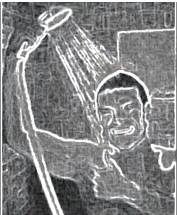 30s with a wife and a newborn baby. This was after an eight-year gap after my bachelor’s, a long gap in which my grasp of the sciences and mathematics had evaporated.
30s with a wife and a newborn baby. This was after an eight-year gap after my bachelor’s, a long gap in which my grasp of the sciences and mathematics had evaporated.
Then, in my 40s, over two decades ago, I started this magazine while holding on to a full-time job — with no experience whatsoever in editing, proofreading, or copyediting; software skills for myriad things, Bulk Mailing, selling ads, bookkeeping… … And this when my older daughter was getting ready to go to college.
Ignorance was bliss.
What have these to do with Cold Showers?†You may wonder. But this preface sets the stage for what follows. Out of necessity, I use the Internet for fact-checking, etymology of words… In this, I’ve come across nuggets of fascinating information. This is identical to the story in Yoga Vaasishtha of a man assiduously searching for a lost copper penny, fortuitously ending up with Chintamani, the wish fulfilling gemstone. But in my search, I am content if I get a nugget, if I get anything at all.
The one I got was on the health benefits of Cold Showers, defined as taking bath in really, really cold waters, at temperatures going as low as 50 F or lower. The health benefits claimed are many, some psychosomatic, others physiological: reduced stress, better alertness, long-term weight loss when done daily, increased testosterone and sperm count, better immune resistance and blood circulation, antidote for depression, better sleep, muscle recovery after injury, better skin and hair… All kinds of information is available on the Internet. Samples:
Scientific Evidence-Based Effects of Hydrotherapy on Various Systems of the Body by A Mooventhan and L Nivethitha (www.ncbi.nlm.nih.gov/pmc/articles/PMC4049052).
Here is a website on the subject: www.coldshowers.com
Here is another: www.medicaldaily.com/benefits-cold-showers-7-reasons-why-taking-cool-showers-good-your-health-289524
These are only the tip of the iceberg floating on cold waters. Also, I have seen sadhus in India taking bath in very cold flowing rivers. I attributed it to their Yogic power for many. And ganja for others, because I remember reading somewhere years ago that ganja and other addictive mind-altering substances help their users to temporarily become insensitive to their stressful situations and their immediate environs.
I was skeptical, but when I learned more, my curiosity got the better of me. I wanted to try Cold Showers, not in summer, not in fall, but in this winter, when the outside temperatures were in the 30s F (~ 0 C).
Being used to hot showers, I wondered where to begin and how. The best advice was to phase myself into it. So this is what I did, step by step:
Note: I am in my 60s and what follows worked for me, though my wife thinks I am crazy. So, after reading this, if you want to be adventurous, talk to your doctor before you start.
- On the first day, before my bath time, I indulged in some serious autosuggestion to get ready mentally. I told myself, “Venkat, after all, you’ve survived forty years of marriage; you went to grad school after a big gap, when you were married and had a baby; you’ve seen two daughters through their teen years. You have seen far worse. Cold Showers can not be any worse. Besides, it is going to be very brief, only for several minutes.â€Â Getting mentally prepared is necessary.
- Then, instead of starting with hot water (~120 F, or ~ 50 C, for me), I started with lukewarm water (~105 F, or 40 C). While under the showers at this lukewarm water, I scrubbed my body head to toe with a washcloth.
- Then, while under the shower, very, very slowly I lowered the water temperature. I stayed there for about 30 seconds, turning around, completely drenching my head, shoulder, back, legs, and front so that my entire body got used to the lower temperature. This is important.
- I lowered the water temperature again — again very gently — and drenched my entire body for 30 seconds to get used to the water.
- I took the water temperature down like this over 6 to 7 minutes.
Our normal body temperature is 98.4 F, or 37 C). So, as the water temperature came close to this, the sense of warmth I experienced vanished.
Then the fun started. When the water temperature was slightly below body temperature (around 92 F, or 33 C), I had the first sense of discomfort. I told myself to get used to the discomfort. I stayed at the lower temperatures for 30 seconds, turning around for my entire body to get used 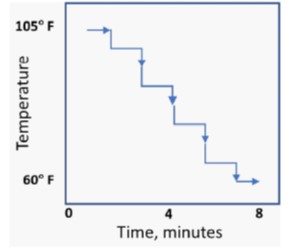 to the colder water. Surprisingly, I got used to it, and I felt OK.
to the colder water. Surprisingly, I got used to it, and I felt OK.
Then, I made the water colder by one more small decrement. I went through the cycle of experience. As the water got colder, I had a initial discomfort for each step down, but I got used to it. Strangely, I even felt a sense of mild exhilaration. The temperature-time profile was something like shown in the sketch on the side.
Then, as the temperature got colder (in the 70s F or 20s C , much colder than 98.4 F, or 37 C), the initial discomfort became acute. I was gasping for breath, breathing deeply and more frequently. But I got used to this too after 30 seconds, till the temperature was low and the discomfort was unbearable. This was my lower temperature limit for that day. Along the way, I screamed with choicest profanities in Tamil, Malayalam, English and Hindi, even Kannada, them language of my early childhood in Coorg, Karnataka. After the showers, I completely dried myself.
During this whole sequence, I was fully alert, living every millisecond in the ETERNAL NOW. At the lowest temperatures, five seconds seemed like eternity. I was mentally detached and unconcerned from everything else, simply because, honestly, I could not think of anything else. Believe me, five seconds seemed an eternity at the lowest temperature limit.
After my shower, I felt incredibly fresh and energetic. I was exhilarated, almost euphoric for no reason. Strangely, paradoxically, and contrary to my fear, I felt a great sense of warmth in my body. I did not feel cold at all. I am sure there are physiological explanations for this in terms of blood circulation, better use of oxygen through diaphragmatic breathing, and hormone secretions…
there are physiological explanations for this in terms of blood circulation, better use of oxygen through diaphragmatic breathing, and hormone secretions…
With each passing day, I lowered my bottom temperature a little. I am now around 50s F or 10 C, for over a month . I intend to stay on this for several months. My goal is to go all the way to ~40 F. I don’t know if I can reach there though.
In any case, getting used to Cold Showers is not as difficult as it appeared to me before I started, and perhaps it is not as intimidating as it appears to you from outside. It is just a matter of mind over matter. But that is what Yogic power is supposed to give to its practitioners. But it certainly does NOT need ganja or other mind-altering substances!!!!!
I already saw another benefit: My wife, who showers after me, now does not complain about not having enough hot water for her shower, and we no longer have disruptive behavior towards each other!!!!
I am in my 60s, and Cold Shower worked for me so far. But then, I’ve done many crazy things in life. So, if you want to try this, talk to your doctor first. The experience — the sense of exhilaration, energy, euphoria and the sense of well-being that stays for hours — is worth it. You will help reduce the carbon footprint, too.    ♠
Home:
Chinmaya Mission Organizes Chinmayananda’s Mahasamadhi Day in 2019
Posted by admin in January 2019, Past issues on January 19, 2019
Ganesh Krishnamurthy               ganeshk76@yahoo.com Â
Regional Coordinator, Chinmaya Mission Pittsburgh
He was waiting, searching and looking to strike. This was the mighty and powerful monkey king Vaali of Kishkinda. He was looking to defeat and destroy Sugreeva, his younger brother. A small misunderstanding was the cause of the enmity. Sugreeva was safely lodged in the Rishyamukha mountains on the outskirts of Kishkinda, because Vaali had a curse that he would drop dead if he set foot anywhere near Rishyamukha, which in Sanskrit means the abode for many Rishis and their ashrams.
Sanatana Dharma or Hinduism is replete with beautiful symbolisms from our sacred texts. In this case, Sugreeva is our individual identity or ‘Jiva.’ The terrible Vaali signifies distractions of the world’s negative forces acting on us. Rishyamukha signifies ‘Satsang’ or the company of pure-hearted and learned people to help us attain ‘moksha’ or freedom from the ill-effects of worldly distractions.
This also is a subtle pointer that the only cure for the maladies of the world is spiritual education. Individuals are the thread woven to make the fabric of the community, society, country and ultimately humanity.
One of the foremost modern Vedantic masters, Swami Chinmayananda, said, “Worldly problems can be solved only by spiritual solutions.†The Swamiji, through the Chinmaya Mission he founded, dedicated his entire life for imparting spirituality to people’s lives through Gnyana Yagnyas and Spiritual camps. He emphasized the balance of head and heart, pointing out selfless work, study and meditation as the cornerstones of life. To celebrate the life and teachings of this ‘second Vivekananda,’ the Mission organizes an annual ‘Chinmaya Mahasamadhi camp’ for the entire family.
In 2019, Pittsburgh’s Chinmaya mission hosts the camp from July 29 to August 4, 2019. Children will be in Balavihar classes and fun activities in the camp while adults get to be in Satsang, mingle with like-minded people in a Sattvik ambience. The topics covered in the camp will be on ‘Sri Krishna Leela,’ Ramayana and the Bhagavad Gita.
For registration and other details, visit www.Mahasamadhi2019.org. Please register to take advantage of the early-bird registration. There is also an option to spread the payments over six months.
We in Pittsburgh have a divine opportunity to engage in this week-long spiritual retreat/camp/festival. We hope that everyone takes advantage of this and extends their support, because remember — “He is waiting, searching and looking to strike.â€Â  ♠
Home:
“To Lend A Helping Hand, All You Need to Do Is Stretch Out Your Hand for Henna!â€
Posted by admin in January 2019, Past issues on January 19, 2019
By Priya Matreja, McDonald, PA

Priya Matreja
For a girl my age — I am fifteen — I feel incredibly lucky to get opportunities to promote Indian culture with my henna skills and be able to raise funds for charity.
Hello, I am Priya Matreja, a sophomore at South Fayette High School. Along with school work, I participate in extracurricular activities, Indian classical dance, and volunteer at various places. But I never hesitate to spare time even on a school night for raising funds for charity with my henna skills. You may wonder how I learned my henna skills.
I casually tried to decorate my hands using henna by watching videos on YouTube in 2016.
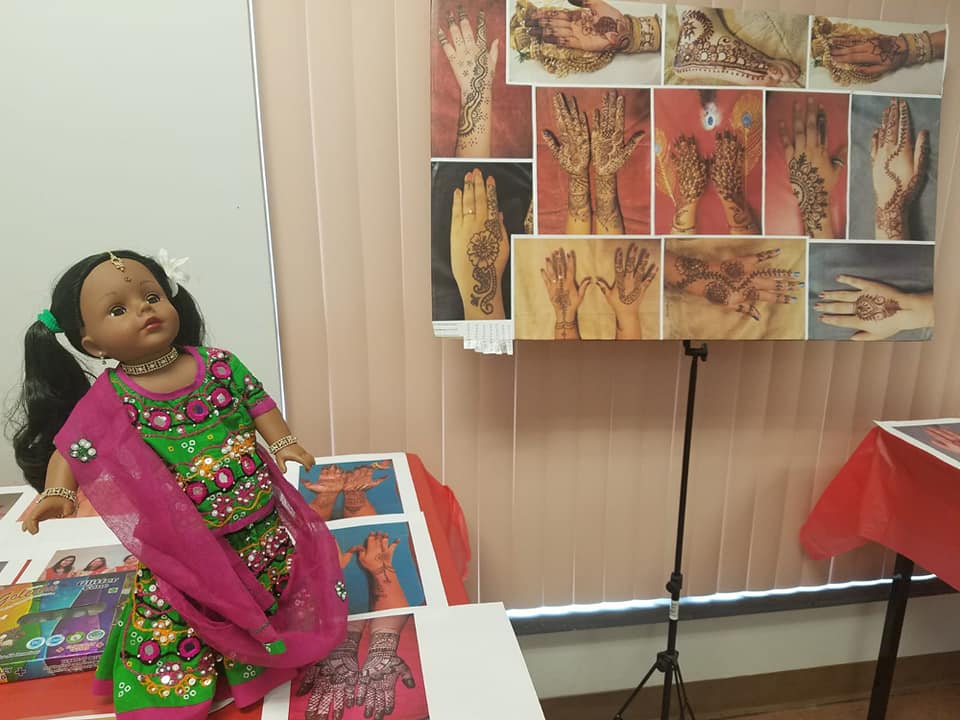
Display in a local library.
Slowly I started getting interested in the art and kept practicing it on my sister’s hands and sketch papers. It was not very long before I decided to make my passion a way to raise money.
Well, what exactly is henna? Henna, also known as mehndi, is an herbal plant-based paste used to decorate hands and feet and other parts of the human body with beautiful designs. These gorgeous designs last from about a few days to a little over a week. It takes a lot of effort to create even one design. First, I must practice multiple times before I present it to customers.
Doing henna also requires immense patience because the lines do not always come out the way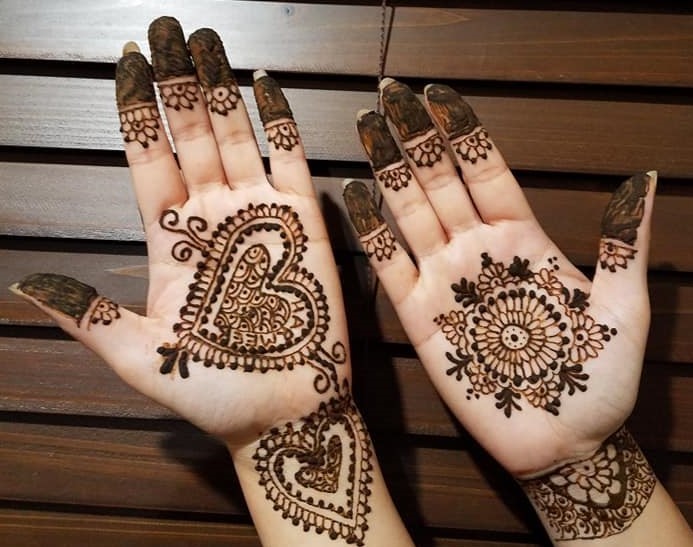 you want them to. Further, to do any design, you must sit for hours creating the design while keeping the customer from moving and ruining the pattern. My henna designs are shown here.
you want them to. Further, to do any design, you must sit for hours creating the design while keeping the customer from moving and ruining the pattern. My henna designs are shown here.
I have spent countless hours applying henna tattoos during Ganesh Chaturti, Teej, Karwa Chauth, Navaratri, Deepavali, and other functions. I also raised money through events such as “Asha†of Nandanik Dance Troupe and Durga Pooja of the Bengali Association of Pittsburgh.
I also demonstrate my henna skills, share information about it, and create awareness about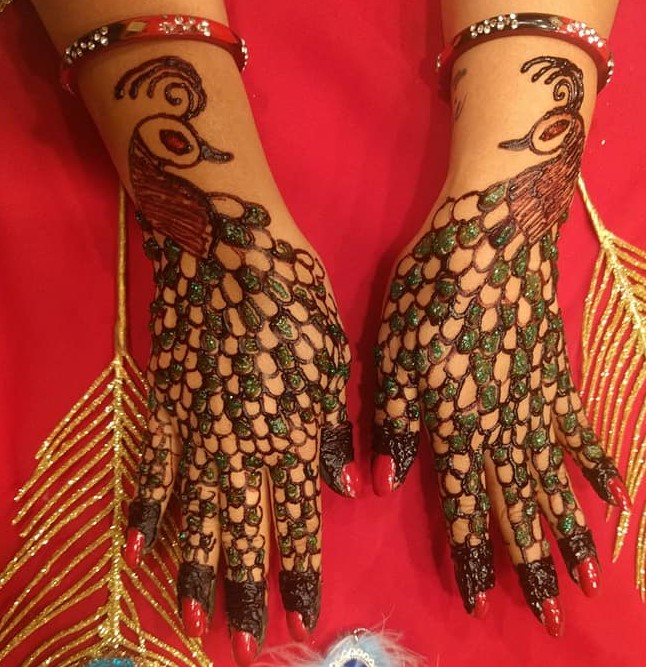 Indian culture in various places. I was given the opportunity to present my henna designs at the South Fayette Township Library’s launch event for cultural awareness, featuring a new doll named Sundari. It’s gratifying to see the amazement on peoples’ faces when they find the variety of beautiful designs and discover how easy and pain-free it is to get the henna tattoo done with mehndi.It gives me great satisfaction when I donate everything that I earn. So far, I have raised about $400 towards
Indian culture in various places. I was given the opportunity to present my henna designs at the South Fayette Township Library’s launch event for cultural awareness, featuring a new doll named Sundari. It’s gratifying to see the amazement on peoples’ faces when they find the variety of beautiful designs and discover how easy and pain-free it is to get the henna tattoo done with mehndi.It gives me great satisfaction when I donate everything that I earn. So far, I have raised about $400 towards 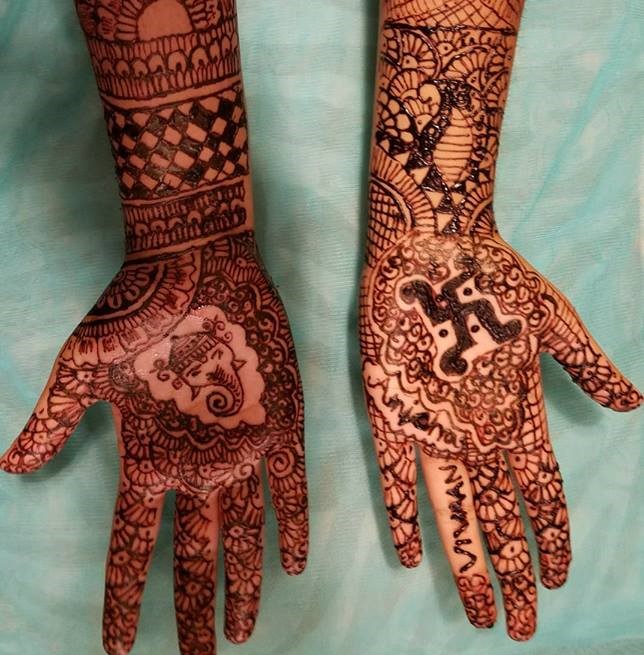 the Kerala Flood Relief fund, the KDKA Turkey Fund (which provides Thanksgiving meals to the needy), Toys for Tots (which gives Christmas gifts to kids who cannot afford them) and others.
the Kerala Flood Relief fund, the KDKA Turkey Fund (which provides Thanksgiving meals to the needy), Toys for Tots (which gives Christmas gifts to kids who cannot afford them) and others.
I think I have made significant progress in my journey as a henna artist, thanks to all my patrons who have encouraged me to come this far. I hope to continue this, because I realize that there are always innovative ways to help mankind.
One of the members of the Bengali Association of Pittsburgh helped me come up with a quote for my endeavor “To lend a helping hand, all you need to do is stretch out your hand for henna.â€
The henna designs shown here are my creations.  My request to all my readers is to consider me for their henna needs in the future to support my endeavor. Thank you. Jai Hind!! God bless America!!   ♠
Home:
The Hindu-Jain Alliance’s Inter-Faith Gathering Against Religious Hatred
Posted by admin in January 2019, Past issues on January 19, 2019
By Premlata Venkataraman      Thepatrika@aol.com
The Hindu and Jain Alliance of Greater Pittsburgh, a newly formed group of Hindu and Jain organizations here, held a well-attended — and well-organized — Interfaith gathering at the Sri Venkateswara Temple on December 9, 2018. The context was the ghastly shooting spree on October 27, 2018 with eleven people shot to death by Robert Gregory Bowers, 46, a resident of Baldwin, PA, inside the Tree of Life Synagogue in Squirrel Hill. Nine of victims were over 65
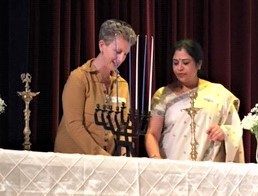
Suchitra Srinivasa helping Rabbi Symons to set up the Menorah flanked by two traditional Hindu oil lamps.
years of age and six were over 75. The theme of the event was Unity in Diversity, based on the Hindu axiom Vasudhaiva Kutumbakam (The whole earth is one family). Coming in the wake of the killings in a synagogue, the theme was poignant.
The participants were Rev. Liddy Barlow (Christian Associates of Southwest Pennsylvania), Mr. Wasi Mohamed (The Islamic Center of Pittsburgh), Mr. Joshua Sayles (The Jewish Federation of Pittsburgh), Shri Som Sharma (Ahinsa), Rabbi Barbara Symons (Temple David), Acharya Vivek (The Chinmaya Mission), and Rev De Niece Welch, (Pittsburgh Interfaith Impact Network).
Two traditional Indian oil lamps flanking the menorah set the mood for the gathering at the temple auditorium. The priest Shri Venkatacharyulu lit the Indian lamps to begin the meeting, as Barbara Symons solemnly read the names of those killed in the shooting spree at the Squirrel Hill synagogue, following which Hindu priests recited Shanti Mantras. The English translations of the mantras were projected on a screen so that the invited guests and the audience could internalize the lofty messages of the mantras. This was a welcome change.
Next Harichandan Mantripragada conducted a brief session of traditional meditation to focus our thoughts on bringing peace within us.
Since it was Hanukkah, members of the Jewish faith lit the menorah amid Jewish prayers in Hebrew. It was a profound moment for the audience to listen to Hebrew prayers and Sanskrit hymns for the peace.
Many members of the various faiths gave messages of peace and unity. The Rev. Liddy Barlow gave a Christian reading emphasizing that we do not have to be identical to coexist.
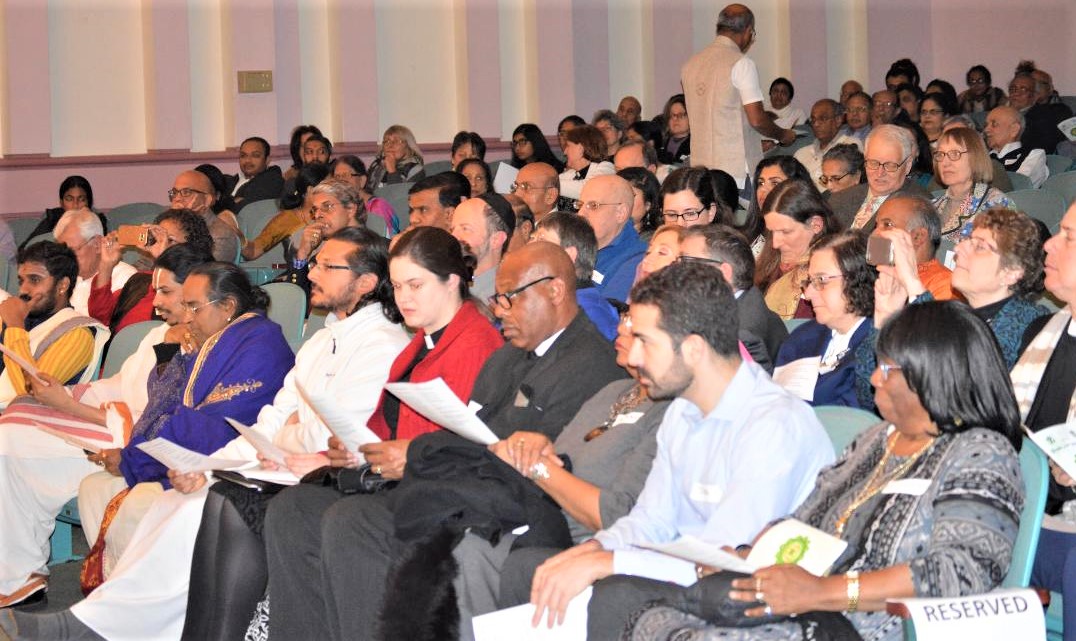
The gathering for the event at the auditorium.
Som Sharma, who for several decades, represented Hindus in many interfaith gatherings inour area, drew on the universal teachings of the Isavasya Upanishads and the Hindu tenet that all streams of the various faiths ultimately lead to Brahman or the Supreme One. The Rev DeNiece Welch echoed the same theme from the Christian perspective: since we are created in God’s image, we should find His likeness in all the differences we find among all of humanity and hence never give into hatred.
Joshua Sayles from the Jewish Federation touched everyone when he said he will
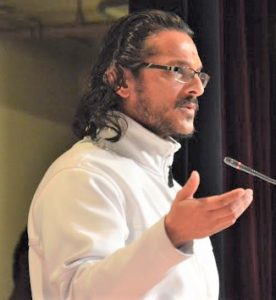
Acharya Vivekji addressing the gathering summarizing the highlights of other speakers.
never ever forget his experience of celebrating Hanukkah at a Hindu temple with people of all faiths in attendance. The hateful events leading to the mindless carnage of the innocents at the Tree of Life may still happen again in other places, he said. But it has brought all of us together in support, so we can become strong again, he said, thus showing us a silver lining in an otherwise mass of dark clouds.
Chinmaya Mission’s Acharya Vivek, who came  from Niagara, Canada, spoke last and summed up the key points of all the speakers who preceded him. He emphasized that individuals working together to understand each other help to remove ignorance and eliminate blind hatred that ends in violence like that happened at Tree of Life.
Law enforcement officials from the Penn Hills and Monroeville municipalities were present at the gathering. Doug Cole, Monroeville municipality’s Chief of Police, told the audience that events like this go a long way to bring communities together.
It was noteworthy that the minimal, but appropriate comments by the two emcees, Nangali Srinivasa and Visala Muluk, enhanced the solemnness of the occasion, as did the translations of the Sanskrit hymns recited.  ♠
Home:
Court-Ordered Redistricting Maps Make Our Congressional Delegation Equitable
Posted by admin in January 2019, Past issues on January 19, 2019
By Kollengode S Venkataraman ThePatrika@aol.com
The midterm elections last November set right the perversion of democracy in Pennsylvania by the GOP-controlled state legislature. In recent decades, the GOP-controlled General Assembly in Harrisburg, after the decennial census, had redrawn congressional district maps. This is mandated by law. However, the GOP in the General Assembly did this in such a way as to give themselves undue advantages in the elections.
Pennsylvania is a moderate state — socially conservative but left-of-center on economic and pocket book issues. In elections for U.S. president and U.S, Senate, the vote split between Democratic and Republican candidates is 45:55 swinging either way. We have voted for both Republicans and Democrats in presidential elections; we have had both Democratic and Republican governors and U.S. Senators.
But the delegation to the U.S. House of Representatives tells a different story. It is skewed badly in favor of Republicans. In the 18-member congressional delegation from the state, the GOP/Democrat split is 13/5, giving undue weightage to Republicans. This is because of the way the GOP-controlled General Assembly in Harrisburg has drawn the maps for the congressional districts, through what is called gerrymandering. States redraw congressional district maps every ten years based on population changes. An article in the April 2018 issue discussed this at length. See here: www.tinyurl.com/Equitable-PA-House-Delegates.
Early last year, in a law suit filed by the League of Women Voters, the state Supreme Court asked outside consultants to redraw the maps to make them more representative of the voting patterns of the state. In the mid-term November elections of 2018, with the redrawn maps for the 18 Congressional districts, the GOP-Democrat split is now 9:9, more reflective of our state’s political character.
Yes, the unpopularity of Donald Trump in the White House also has contributed to this shift favoring Democrats. But even without Trump at the White House, with the redrawn map, the delegate to the US House of Representatives from the Pennsylvania would have been more equitable, more like 10/8 in favor of the GOP instead of 13/5.
Thank you, the League of Women Voters, for bringing the law suit to the Pennsylvania’s Supreme Court. Thank You, the State Supreme Court, for forcing the redrawing of the maps for Congressional districts and making it truly representative of the ethos of our citizens.
This gerrymandering is common also in Democrats-controlled states and cities, where Democrats give themselves undue advantages in elections to stage legislatures and city councils. Gerrymandering not only perverts the very idea of “Representative Democracy, but also always leads to corruption at many, many levels.
==============================================
How changes in the population of our state relative to the population of the nation affect our political clout:
The plot below encapsulates the population dynamics of our home state of Pennsylvania in relation to the population of United States.
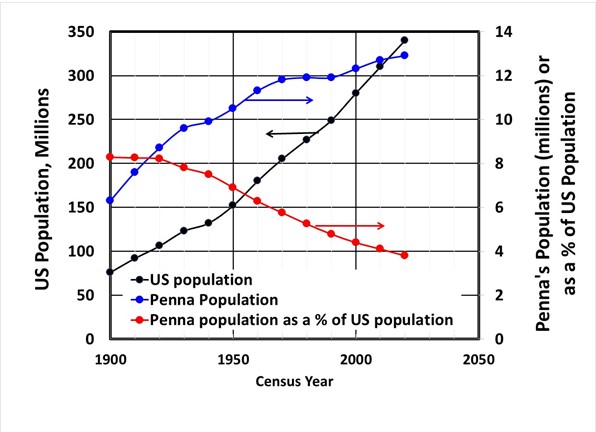
The U.S. population has been growing quite rapidly in the last century, from 76 million in 1900, 200 million in 1920, 250 million in 1990, to 320 million in 2020. The black line in the graph. The population of the state of Pennsylvania is leveling off (blue line in the graph)we were just over 6 million in 1900, 10.5 million in 1950, over 12 million in 2000, and currently around 13 million. As a result, the population of the state as a percentage of the population of the nation has been declining (the red line in the graph). We were 8% of the nation’s population in 1900, and now we are under 4% of the nation’s population.
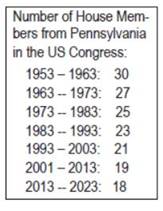
The total number of members in the US House of Representatives in the US Congress is 435, fixed by the constitution. The number of House Members in each state is based on the population of each state relative to the population of the nation. Since the population of Pennsylvania as a percentage of the U.S. population has been declining, the number of House members from Pennsylvania in the US Congress has been declining. We had 30 members in 1950s. Now, only 18. See the table.
Republicans, having a majority in our state’s General Assembly in Harrisburg for long, have skewed the redrawing the maps of the congressional districts. The split between the two party’s Congressional delegation from Pennsylvania, is nothing but a scandal.
Again, remember, Pennsylvania is a moderate state, and we have elected people from both parties to state-wide offices. And the vote split in state-wide elections are generally narrow, 55-45, swinging either way. In this background, here are the numbers of GOP and Democratic Congressmen from the state:

Thus, Republicans had 67% of the state’s 18-member Congressional Delegation to the US House, even though the state votes 45-55, swinging either way in presidential and Senate races. This gerrymandering is not unique to our state. Democrats indulge in the same perversion where they are in majority
Finally, with the state Supreme Court’s order for redrawing the maps, in the midterm elections in November 2018, the split in the 18-member Congressional delegation is 9/9. ♠
Home:
Nilakantha Dikshita: A Lesser-Known, but A Great Sanskrit Poet of the 16th Century
Posted by admin in October 2018, Past issues on November 18, 2018
By V Krishnaswami, Ross Twp., PA
e-mail: vkrishnaswami@comcast.net
Editor: V. Krishnaswami, a longtime resident in our Metro area, grew up in Tamil Nadu. Sanskrit was his second language in high school, and also at the Loyola College, Chennai. He was taught Sanskrit at home by both his grandfather, an erudite scholar in the language, and his father, who was well versed in both Sanskrit and Classic Tamil. Both were lawyers. Krishnaswami’s interest included Kavyas (poetry), scriptures, stotras (hymns)… He has read Sanskrit dramas in the original — the works of Bhasa, Kalidasa, Dandi and Bhabhuti. His interest in Appayya and Nilakantha Dikshita started when his grandfather taught him Nilakantha Dikshita’s Shanti-vilasam. He feels that Sankara’s Brahmasutra Bhashya is a masterpiece in literature, logic and hermeneutics (the subject dealing with the theory and methodology of interpretation wisdom literature, and philosophical texts).
Krishnaswami came to Pittsburgh in 1973 as a fellow in cardiology at the then Presbyterian University Hospital. He practiced cardiology in Pittsburgh at Mercy and UPMC between 1988 and 2017. He was a clinical professor at the University of Pittsburgh’s School of Medicine. Now retired, he was involved in teaching and research all through his career.
Sanskrit is the mother of Indic subbranch Indo-European languages. ‘Samskritam’ literally means a language of perfection. The beauty of this “language of the Gods†was elucidated by William Jones(Chief Justice of Supreme Court in Bengal at the time of Warren Hastings) in his address to Asiatic society on February 2, 1786: “Sanskrit language …is of a wonderful nature, more perfect than the Greek, more copious than the Latin more exquisitely refined than either.â€
If you poll the people in India where Sanskrit as a language is well known even if not spoken or understood, about Sanskrit poets, I will be surprised if they can name anybody beyond Kalidasa. Some may have heard of Dandi, Magha, may be even Bavabhooti. Sanskrit poesy appears dead after the time of these masters. But hat is not true.Â
It was prevalent in religious works of Sankara and his disciples in 8th century, Ramanuja (9th/10th century) and later, Madhva in 11th century. Many people wrongly think there was no Sanskrit poetry after 12th century. even though it was not flourishing. Tulasidas Goswami (16th century). Muthuswami Deekshitar (18th century) are great Sanskrit Bhakti poets.
Nuilakantha Dikshita was a Sanskrit poet, born in South India in 16th century. He was born in the illustrious family of Appayya Dikshita. We know that he was born at the end of 15th century and lived to about middle of 16th century. Neelakanta was a genius, great poet, philosopher and a distinguished statesman. He was the chief administrator during the rule of Thirumala Nayaka, ruler of Madurai, a splintered state after the collapse of the Vijayanagar empire.
Impressed by the young Nilakantha’s exposition of the text Devimahatmyam, the King Tirumalai Nayak was so impressed that he offered him a position as an administrator in his kingdom. His exquisite poetical works go beyond Bhakti, and are known for their humor, suggestion, sarcasm, Slesha (double entendre) — all in measured quantity.
His works include plays (his magnum opus being Nalacharitra Nataka) epic poems like Siva-leela-arnavam and Gangavataranam. His minor works include Kalividambanam, Sabaranjana Satakam, Santivilasam  reflecting the hypocrisy in the society in Kaliyuga among various professions. Some of his works are not extant and some only partially available.
Neelakanta Dikshta’s poetry is like honey in a bottle. The pleasure starts right with the look, easy to obtain and sweet, unlike the works of some great poets. For example, Bhavabhuti whose works are heavenly, are like cool coconut water in summer, but you have to get the fibers out and break the shell before you enjoy it. Dikshita’s style is simple, his words are fluent and spontaneous coming from the heart (Sahrudaya), with not much of grammar problems. His descriptions of nature in Gangavataranam is splendid. He also wrote heart-melting Bakthi poetry in which in spite of all his scholarly understanding of the Upanishads, he makes a case that one can attain liberation only by totally surrendering to God and through His Grace — Her in his case, since he was a bakta of Goddess Meenakshi, the presiding deity of Madurai temple) — and not by Gnana (knowledge) alone, somewhat akin to Martin Luther’s idea of Grace.
Here is a sloka from Anandasagaratavam a beautiful work in prayer to Goddess Meenakshi of Madurai:

Translation:
How many different recensions (Shakha) there are in the Vedas!
How many different Upanishads in each of these recensions!
How many births will be needed for mere rote learning of these texts — Not to speak of the study to understand their meaning!
In this profound verse the poet rhetorically says, any amount of knowledge acquired by the study of Vedic or other religious texts alone without God realization (for which you need God’s Grace) will not bring hope for liberation in this life.
Editor: We will share with readers other examples of Neelakanta Dikshita’s poetry in the ongoing issues. Â
Home:
Bhamini and Vaishnavee’s Delighful Karnatic Arangetram
Posted by admin in October 2018, Past issues on November 18, 2018
By P Sundararaman, Allison Park, PA
e-mail:Â psundararaman@hotmail.com
All children are natural musicians. Obsession to music is what makes them talented. Right training and rigorous practice can make them performers, if they so desire. Bhamini and Vaishnavee, teenage daughters of Hema and V Sundararaman, gave an impressive debut vocal Karnatic duo recital at the SV Temple auditorium on Sunday, July 8, 2018. Rasikas, discerning and common alike, enjoyed the concert, encouraging them with well-deserved applause.
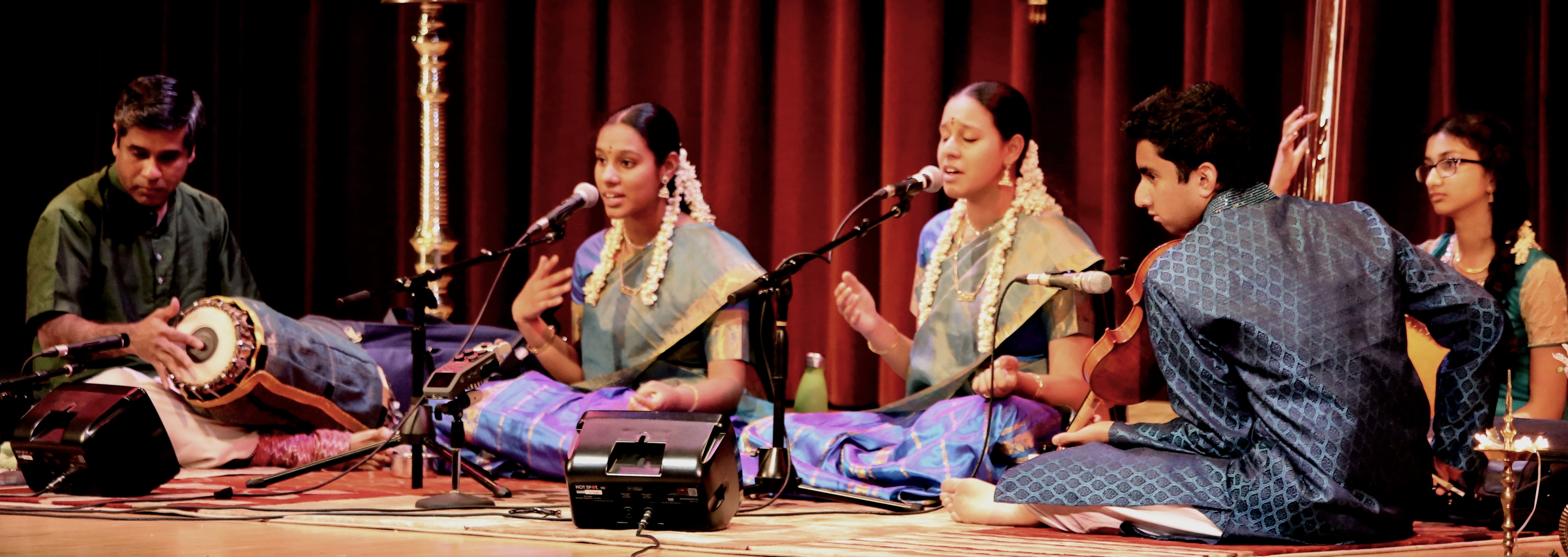
Their Guru — Tirumala Penugonda Chakrapani and Seethalakshmi Madhavan — have given them a firm foundation in fundamentals of Karnatic music, further kindling their desire for creative music. “Creative†music, by implication, cannot be “taught.†Guru can only illustrate how to approach it. The student should assimilate these guidelines and practice creative singing with raga embellishment, neraval, kalpanasvaram, with the Guru and then by themselves, till they become confident that the rules and restrictions are not violated. Creative music cannot be memorized and reproduced, it is improvised on the spot.
Bhamini and Vaishnavi began their concert with an invocatory sloka followed by a well rendered rare varnam in Kharaharapriya composed by musicologist Pinakapani. The fifteen krtis of various composers presented by the sisters, were all set to different talas and ragas. The kritis were sung with chittai (proper diction and precision); a proof of their rigorous practice. They delineated raga and svaraprastara for several kritis.
Parvati Ninnu in the raga Kalgada, Muruga in Saveri, Ekkadi Narakamu in Nitimati (a rarely heard raga) were noteworthy. The well-presented center piece Kaddanu Variki in raga Todi with detailed alapana and neraval and the sisters singing complimentary one-avartana svaram were enjoyable. Their 3-hour concert with no break remarkably maintained a steady tempo throughout.
The young, talented accompanying artists — Sarang Mulukutla on the violin and Ganesh Sankaranarayanan on the Mrdangam — supported the young singers very well. Anjali Bandi on the tanpura provided the critical shruti accompaniment. These five young artists jointly made the Arangetram to a near-professional performance.
I have listened to Bhamini and Vaishnavee from their childhood. Their passion for Karnatic music — instilled by their grandmother— should help them widen their horizon by learning and listening.  ♠
Home:
Our Kailash-Manasarovar Pilgrimage
Posted by admin in October 2018, Past issues on November 18, 2018
By Vish and Akila Iyer
e-mails:Â vishviyer@yahoo.com and iyer1957@gmail.com
Editor’s Note: Vish Iyer, a physician, and Akila Iyer, a financial manager, live in Fox Chapel. Spirituality transcending religion, they say, is the goal they seek in life.
Mount Kailash is revered by millions of Hindus as the abode of Shiva. Pilgrimage to visit to this sacred mountain and lake Manasarovar is the life-long ambition, not only for the Hindus, but also Buddhists, Jains and the followers of the Kom religion.
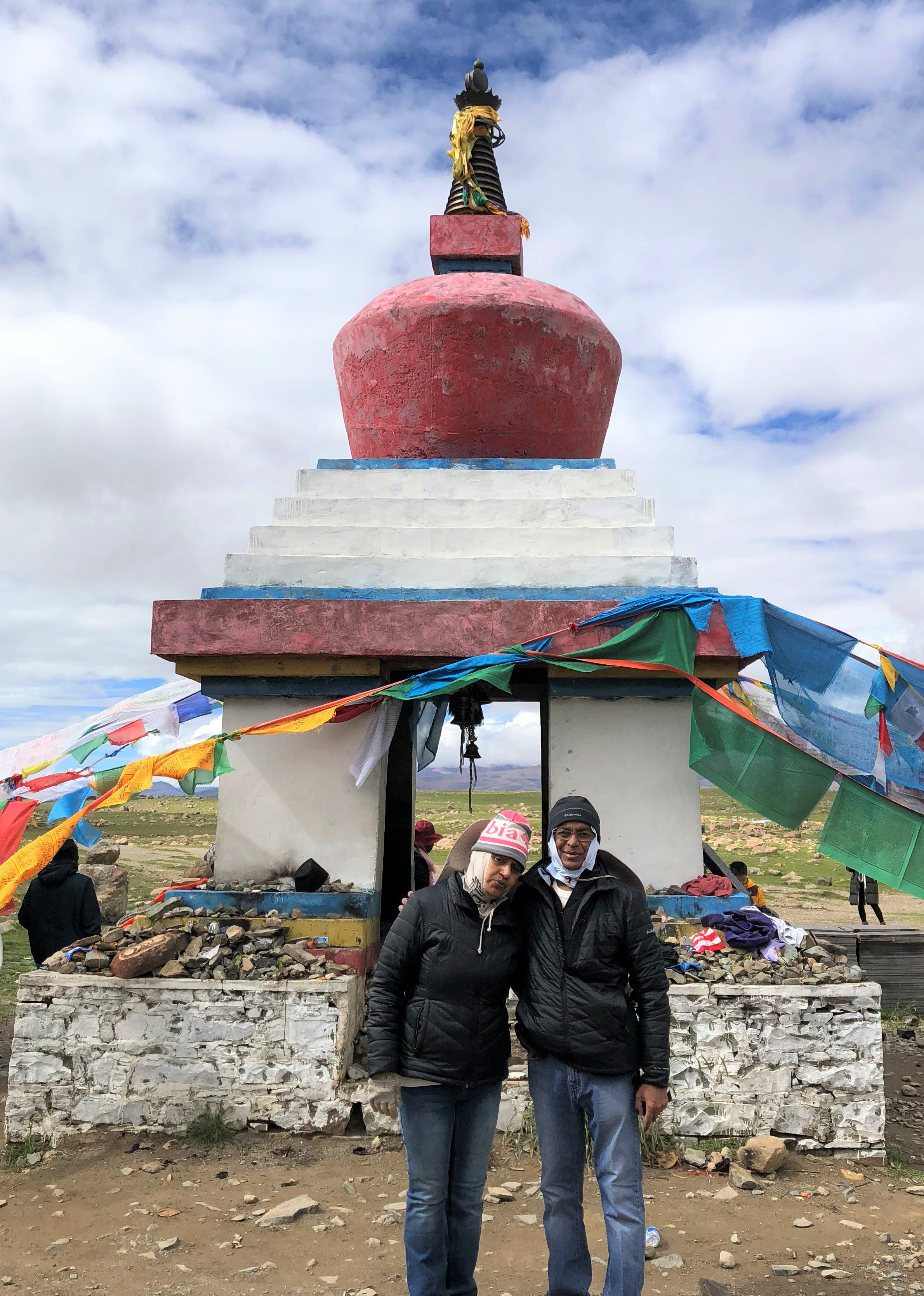
The authors at Yamadwar, the start of the Parikrama.
The vedas, the sacred texts for the Hindus, do not start from the first word and end with the last one. Of the four. Rig, Yajur, Sama and Atharvana Vedas, Yajur Veda is widely practiced. Yajur Veda has 7 chapters and the middle of the fourth chapter is Sri Rudram. And the center of Sri Rudram are the syllables Si-Va. Thus around Si-Va is constructed Sri Rudram and around Sri Rudram is constructed the Veda. For the first time ever, Atirudra Mahayagna — that is chanting Sri Rudram 16,461 times — and performing Havan was organized at Mount Kailash, for world peace. Chanting Sri Rudram invokes Siva Himself and performing Yagnam (Homa) simultaneously ensures His presence.
Getting to Tibet is either via Nepal or China. We chose the Chinese route, which requires that we had to go as a group, since individual permits are not allowed in Tibet. Lhasa, the beautiful capital of Tibet, is filled with lovely people who are culturally conscious. Chinese presence is felt in every aspect of day to day living. The Potala Palace, the headquarters of the Dalai Lama is occupied by the Chinese.

 A busy thoroughfare in Lhasa, Tibet.
After acclimatizing for a day in Lhasa, we proceeded by road to Xigatse. The mighty river Brahmaputra gave us company during the long drive. After a night of acclimating in Xigatse, the next night was spent in Saga. Electricity is available only from 8 PM to midnight at Saga and other towns above this altitude.

A majestic view of Mount Kailash, the very purpose of our trip.
First stop was the sacred Lake Manasarovar where we were blessed with the sight of the third moon representing Siva Himself. There are two lakes, Lake Manasarovar and lake Rakshastal that are side-by-side. Lake Manasarovar is filled
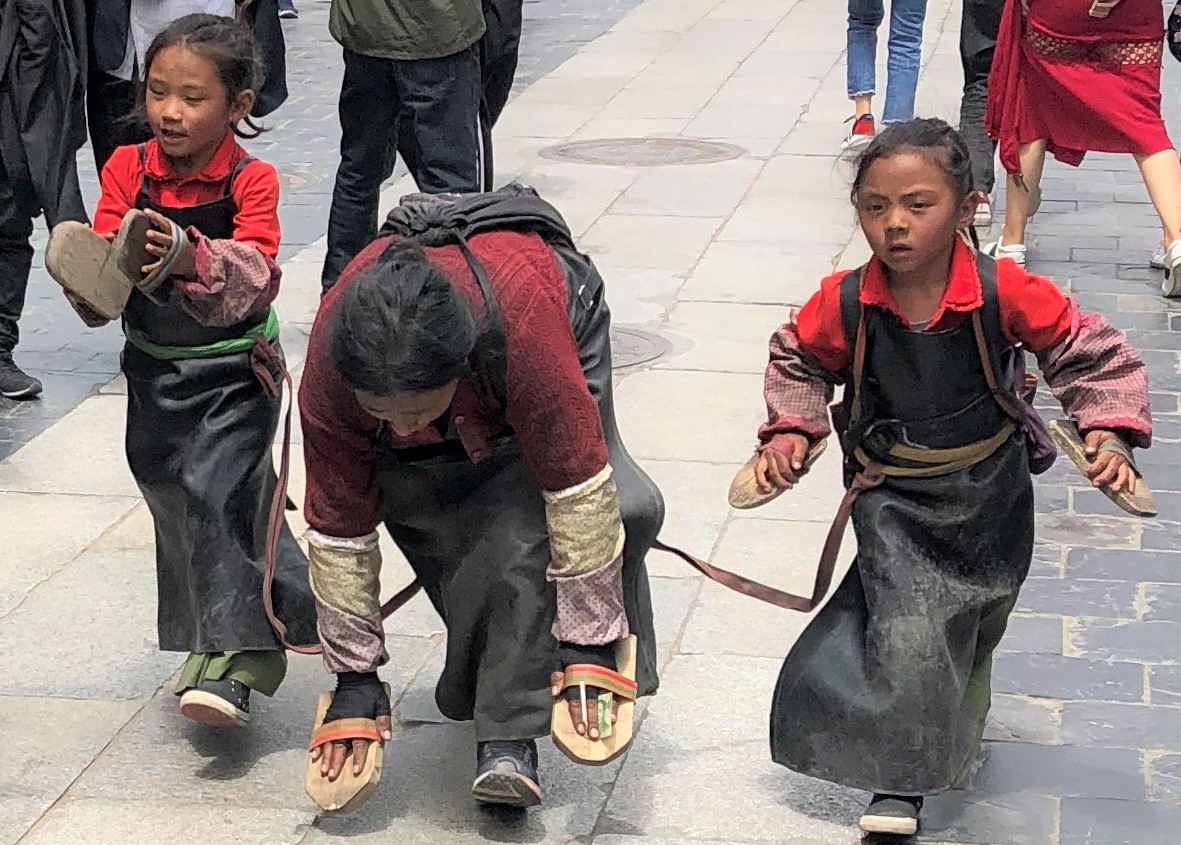
A Tibetan Buddhist, with help from her two children, doing the parikrama. for every four steps, she does an Pranam.
with life and there are birds and other forms of life. While Lake Rakshastal is devoid of any form of life. The legend goes that the waters of lake Rakshastal is unfit for consumption as this was the place where the demon king Ravana did his penance and lifted Mount Kailash. And, the legend goes, Ravana got punished by Lord Siva who squeezed Ravana under the holy mountain.
Our base camp at Darchen is situated at an altitude of 16,500 feet. The partial pressure of oxygen gets low at these altitudes and any form of physical activity takes lot of effort. Many moons ago, as a young Captain in the Indian Army, I’ve experienced it along the Chinese border in Sikkim.
Because of various delays in delivery of Yagnam materials and other logistical hurdles, the Yagnam was delayed. We embarked on a 3-day Parikrama of Mount Kailash with basic supplies including plenty of high calorie food for the arduous trek. Each pilgrim had a porter who would carry a small backpack.
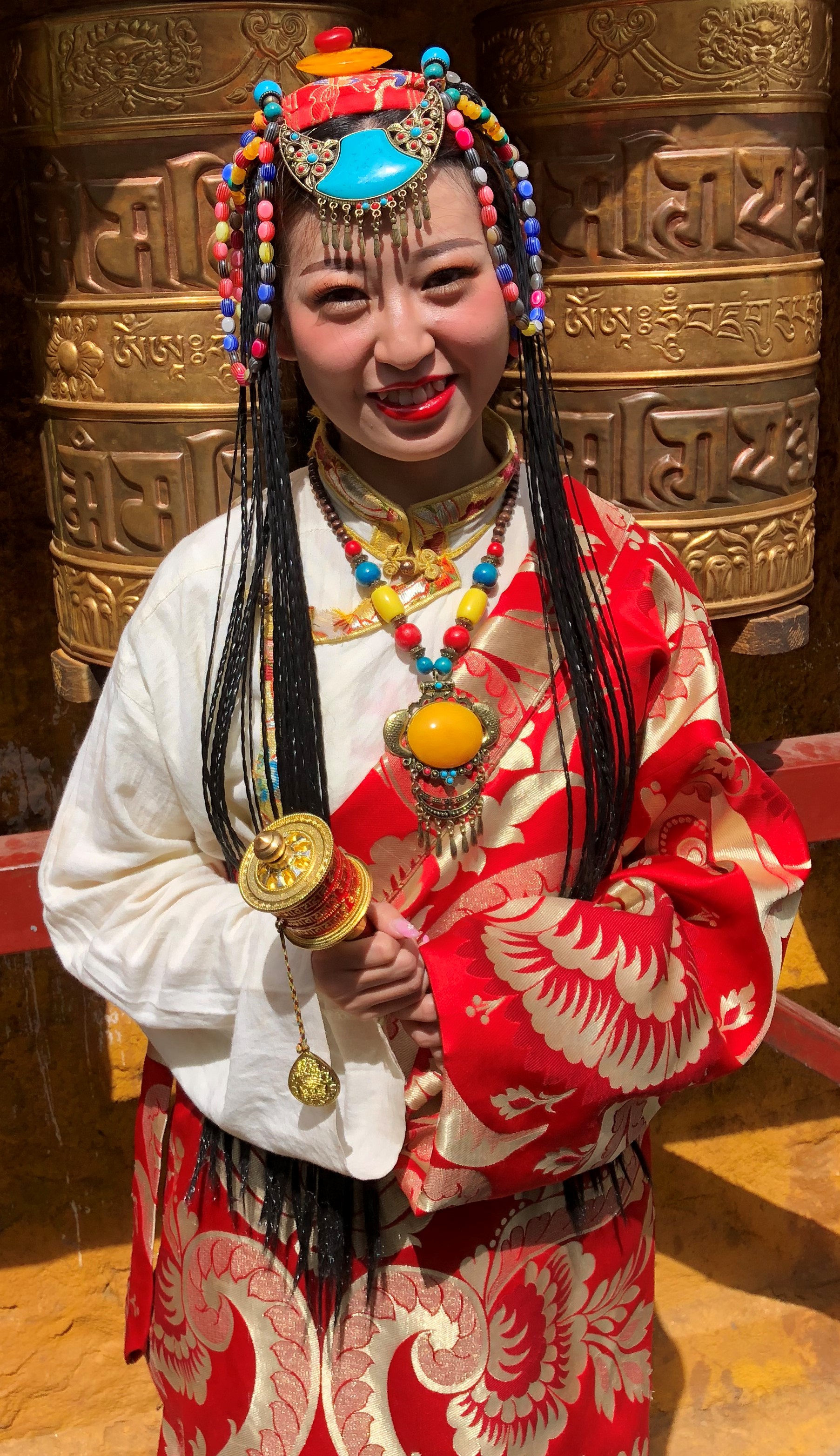
A Tibetan bride on her Big Day in he traditional Braial dress.
In addition, there was also a horse and the horseman as a back-up, if one is unable to walk. The starting point was Yamadwar near Darchen.
Buddhists believe in Parikrama, but they do full prostration after every four steps. It takes them 25 to 30 days to complete the entire length of 52 km. Bon religion has two categories, white Bon
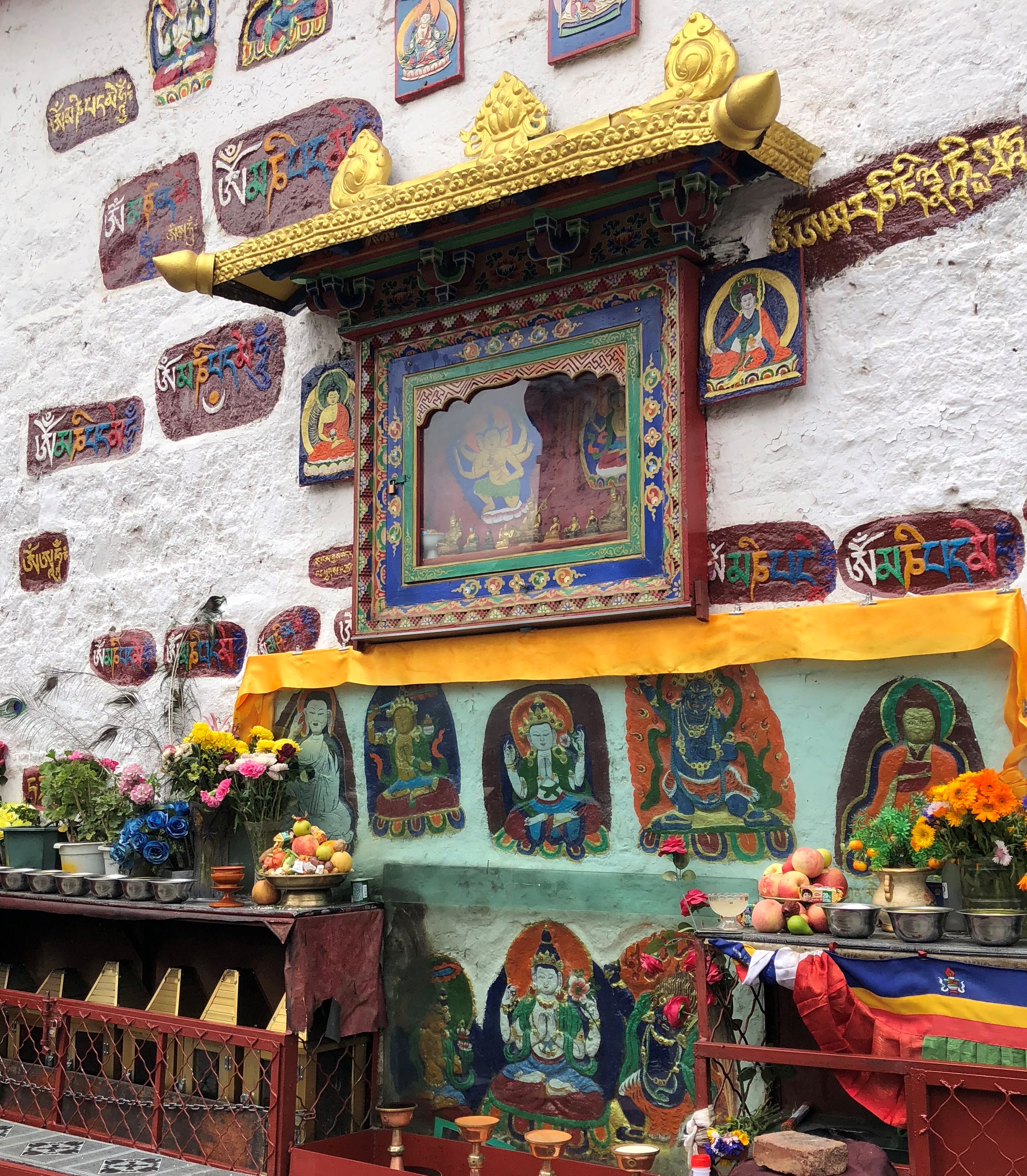
A Buddhist Temple along the way.
that is quite compassionate and the other is Black Bon. Interestingly, those who practice Black Bon do the Parikrama in an anti-clockwise direction. Their practices are somewhat similar to Islam.
At the end of the first day, we spent the night as close to Mount Kailash as possible near the north face with a divine darshan of Mount Kailash.
The second day was the most difficult portion of the trek. It involved climbing to an altitude of 19,500 feet to Dolma La pass. The terrain was steep and uneven. Breathing was certainly challenging! Soon after we could see Gauri Kund, and also had darshan of Hayagriva. According to the Buddhists, this is one of the three
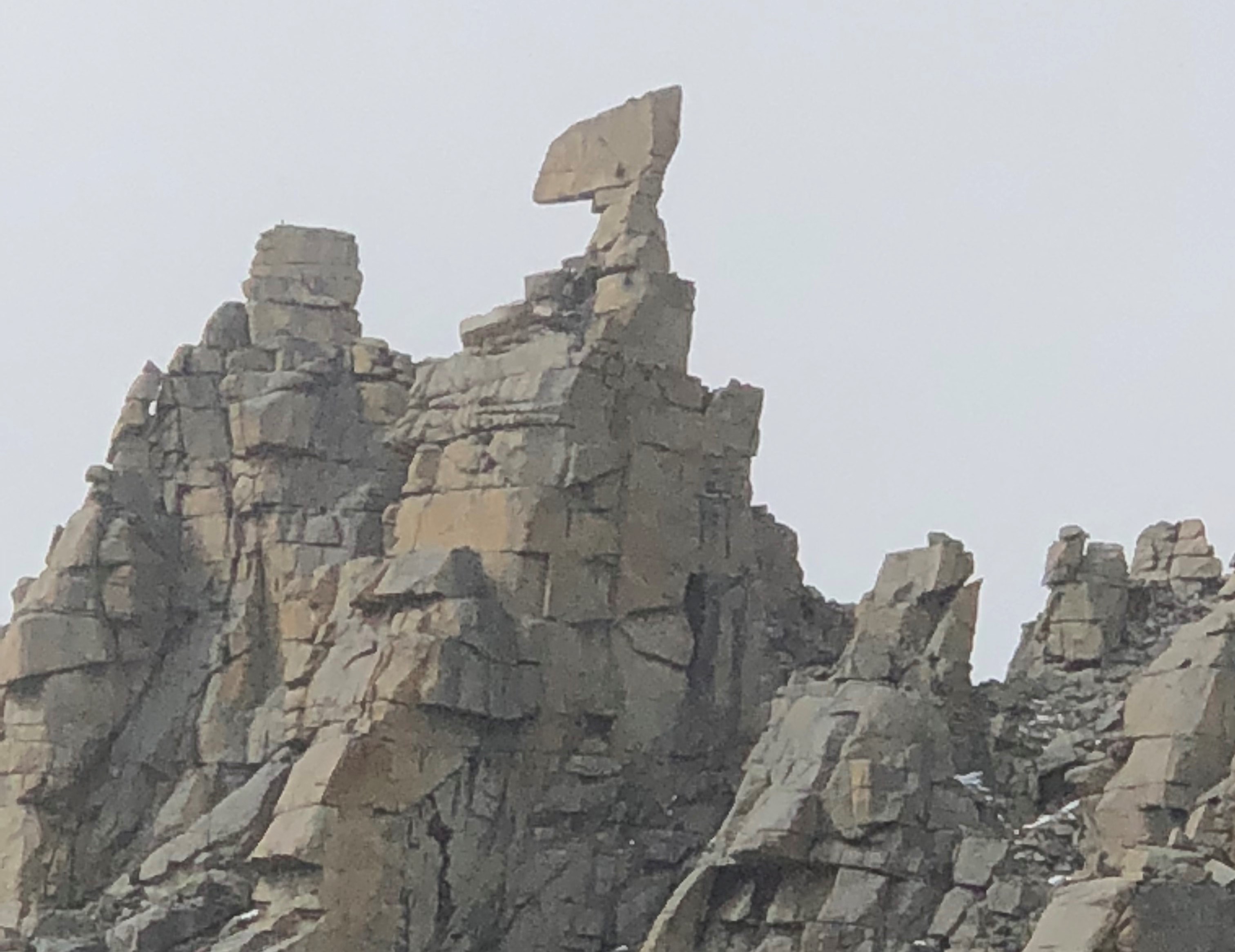
The Hayagriva Mountain Peak, a work of art by Nature done over thousands of years in bone-chilling cold and blistering winds.
holy sites of Hayagriva who they recognize as an incarnation of Lord Vishnu.
Climbing down was tricky where the surface was wet and uneven, but the breathing was definitely easier. The second night was spent in rather basic conditions in a guesthouse. Appetite
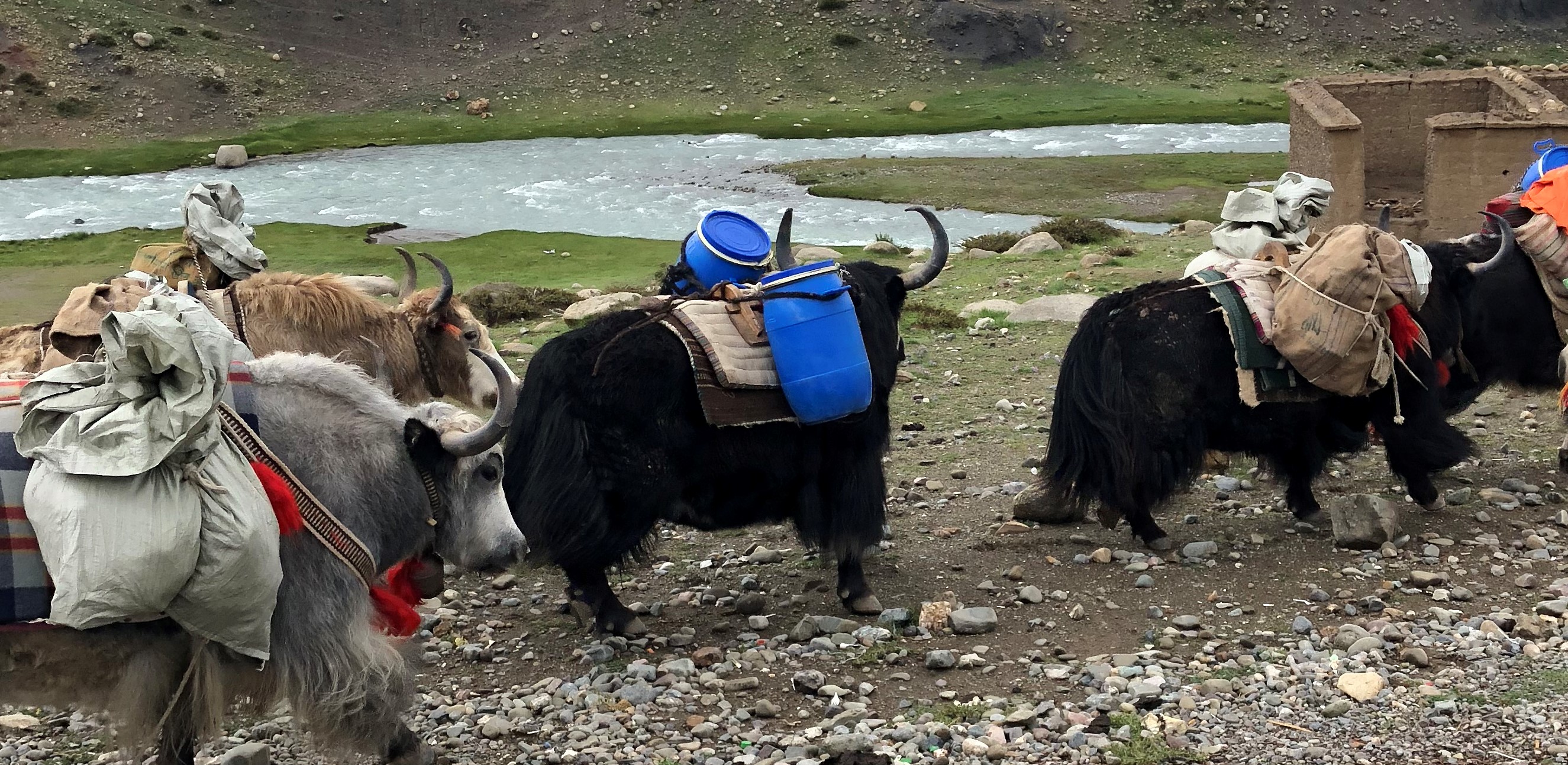
Yaks, the beasts of our burden, very critical for our trekking.
was literally nonexistent. Plenty of fluids and prophylactic medicines to prevent high-altitude sickness are vital.
The third day of the Parikrama was a lot easier on an even surface and it
involved another 20 km of trekking. At the end, it was a welcome sight to see the waiting buses to take us back to Darchen. We thanked our porters and horsemen and reached Darchen.
Our last day was partially spent in taking part on the Ati Rudra Maha Yagnam. The ambiance was divine. We thanked everyone and started our return journey. Our descent was along river Brahmaputra, back to Lhasa. One more quick appreciation of beautiful Tibet before flying back home, to Pittsburgh. Â Â ♠
Home:
One Upset Trump Supporter Angrily Responds
Posted by admin in October 2018, Past issues on November 18, 2018
K S Venkataraman
E-mail:Â ThePatrika@aol.com
In the wake of articles in the April and July issues of the magazine on President Trump’s presidency, one reader was quite upset and penned this e-mail:
Editor:
Shame on Patrika becoming anti-Trump mouth piece for Indian Diaspora in the Allegheny County. U.S. economy return 4.1% growth and now average 3.1% growth for the last six months. U.S. economy couldn’t rise above the 2.2% doldrums of the Obama years. Tax reform broke the bottleneck on capital mobility and investment from the highest corporate tax rate in the developed world. Tax reform and deregulations have lifted U.S. Economy from Obama/Clinton doldrums.
Stop playing identity politics or caste politics like Democratic Party.Â
Jay Goonetilleke
Former GOP Candidate in West Mifflin
In all democracies, when the stock market, the GDP growth rates and unemployment numbers do well, the presidents/prime ministers and the ruling parties take credit, whether they deserve it or not, or whether they had anything to do with these numbers are not. Similarly, when these numbers go southward, opposition parties leave no opportunity to berate the ruling establishments for their gross negligence in not paying attention to “the pain and suffering of the ordinary, hard-working citizens.â€
As we all know, changes in these numbers (upward or downward) have multiple contributing factors, some domestic, and others, on account of events and trends occurring in overseas. Very often, the ruling establishment have no influence over these events, not to speak of any control.
Discerning readers and those in the know of the rules of engagement in politics know that this strategy is how the game of politics is played.      Â
When Trump and his supporters take credit for economy doing good (as the writer above does) under his watch (whether he has anything to do with it or not), they should extend the same courtesy to Obama, again whether Obama is directly responsible for these numbers or not.Â
So, we feel compelled to share with readers some of the general observations we have already published earlier on the eight years of the Obama Administration and the two years under Trump.Â
Since most of the readers of the magazine are college-educated, I present these observations as charts in the hope and expectations that readers can read these charts and make their own judgments:
On the Dow-Jones Average:
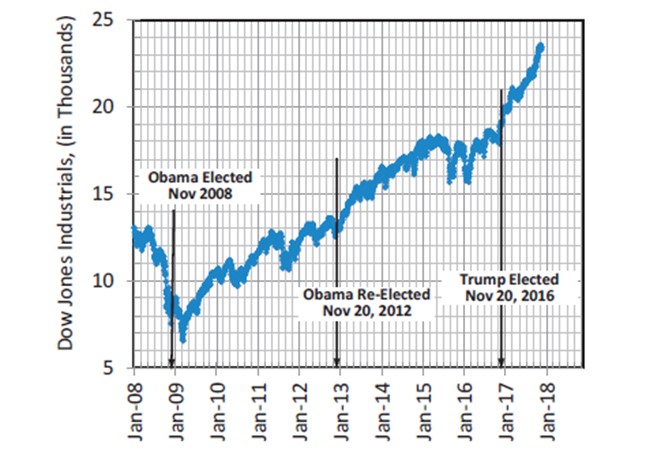
On Unemployment Rates:
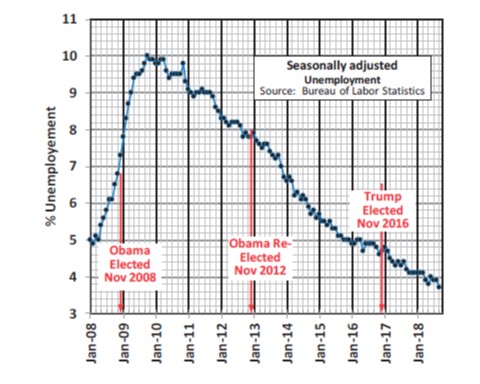 ♠
♠
Home:
Why Is Coronary Heart Disease Such A Big Problem Among Indians?
Posted by admin in October 2018, Past issues on November 18, 2018
By Dr Padma Garvey, MD Hudson Valley, NY
e-mail:Â pgarveymd@gmail.com
Editor: Padma was born in Nellore India and grew up in Pittsburgh. She earned her medical degree from the  University of Pittsburgh in 1992. She is a full-time gynecologist in the Hudson Valley area, married to her physician-husband for 25 years. She has two kids in college. She practices yoga and is dedicated to teaching people about the benefits of a plant-based diet. She has a website (www.drpadmagarvey.com).
University of Pittsburgh in 1992. She is a full-time gynecologist in the Hudson Valley area, married to her physician-husband for 25 years. She has two kids in college. She practices yoga and is dedicated to teaching people about the benefits of a plant-based diet. She has a website (www.drpadmagarvey.com).
Asian Indians have some of the highest rates of coronary artery disease and diabetes in the world. I know from personal experience that many Indians are lulled into a false sense of security because they tend to be vegetarians. My own father, the late Dr. K N Rao, had diabetes. Eventually, he needed bypass surgery, but this extended his life by only two years. In addition, those two extra years of life were spent confined to a bed. Though my father had always been a strict vegetarian, he ate a high fat diet. Dinners included chutneys, ghee on lentils, fried papadam, fried pooris, tamarind rice with lots of oil and white rice, fried samosas, sugary laddoos, sugary jilebis, and yogurt. In addition, the typical Western snacks crept into his life. He ate potato chips, ice cream, candy, and cakes.
There is lot of misinformation about what a healthy diet includes. We hear fat is bad, fat is good. We hear that carbs are the enemy. We hear that protein-centered diets like the keto diet or paleo diet are bad for us.
In actuality, the evidence regarding a healthy diet has been known since the 1930s when Dr. Ancel Keys conducted the famous Seven Country Study. Keys found that countries that consumed low fat diets had better health than countries that consumed high fat diets. In particular, Keys found that the Okinawan and Mediterranean diets in 1930 were extremely healthy having 10-18% total fat.
I came across an interesting study published in the prestigious medical journal The Lancet in 1959, entitled “Serum Cholesterol, Diet, And Coronary Heart Disease in Africans and Asians in Uganda†by Shaper et al. At the time of the publication of this study, coronary heart disease (CAD) was nonexistent among African Ugandans. This alone is a shocking statement since CAD is the Number One killer of African Americans today. While CAD was nonexistent in the African community, it accounted for 43% of all deaths over the age of 30 among Asian Indians in Uganda at that time.
The authors examined the diets of the two communities. The African Ugandans ate a diet which included green leafy vegetables, maize, millet, yams, and beans. They ate very little meat and absolutely no dairy. They did not utilize much cooking oil in their cooking and consumed whole grains. In contrast, the Asian Indians in Uganda in 1959 were consuming white rice, lentils, butter/ghee, yogurt, milk, and lots of cooking oil. The total fat calories in the African Ugandan diet was about 18%. The fat calories in the Asian Indian diet in Uganda was 35-40%.
The typical middle-class, vegetarian Indian diet is even worse today. In general, vegetarian Indians are consuming more refined grains, added sugars, oils, animal dairy, and even cheese. A low-fat, whole grain, plant-based diet has been the only diet ever shown to reverse heart disease. This study conducted by Dr. Dean Ornish was published in the Lancet in 1990. When it first appeared in The Lancet, the results were so startling that many in the medical community felt that it would revolutionize the way CAD was approached and treated. Dr. Dean Ornish even made it on the cover of Time Magazine with the subtitle asking if this was the end of heart disease.
Unfortunately, the fact that Ornish published his ground-breaking research in the British journal, The Lancet, suggests that the American journals passed on it. Around the 1960s, most American medical journals, American medical societies, and even American medical school education were supported by the pharmaceutical industry.
President Bill Clinton suffered a heart attack shortly after he left office. He had bypass surgery. After his surgery, he was on the standard regimen of medications including cholesterol-lowering drugs and told to follow the American Heart Association (AHA) diet. Interestingly, though the Ornish diet was the only diet ever shown to reverse plaques, the AHA recommends the less effective DASH diet. Clinton was quite frightened after his heart attack and followed his cardiologist’s recommendations.
About 18 months later, President Clinton had a re-occlusion or buildup of plaque in his heart. He underwent angioplasty. I remember watching reporters questioning Clinton’s cardiologist at the time. The reporters wanted to know why Clinton had a recurrence of his heart disease despite following the AHA guidelines. The cardiologist said, there was nothing more that could be done about it and that Clinton had bad genes.
Clinton was not satisfied with this response and talks openly about seeking other treatment options. Clinton came across the Ornish study and went to Dean Ornish for guidance. Clinton became a strict low-fat vegan. His daughter, Chelsea, is also one. Since following the Ornish diet, Clinton has been heart disease-free. The past president of the American College of Cardiologists, Dr. Kim Williams from Rush Medical Center says that there are only two kinds of cardiologists, vegans and ones who are unaware of the data.
Indian physicians must be made aware of the proven benefits of a low-fat, whole grain, plant-based diet. We need to educate the Indian community as well as all our patients to avoid needlessly painful, early, and costly deaths. Excellent resources for more information are on the Physicians Committee for Responsible Medicine (PCRM) website.
♠
Home:
Time to Reform Cremation/Death Rites for Hindus in the US
Posted by admin in October 2018, Past issues on November 18, 2018
By Kollengode S Venkataraman
e-mail:Â ThePatrika@aol.com
Editor’s Note: A slightly modified version of this article appeared in the April Issue of Hinduism Today.
Death rituals — burials and cremations or other practices — are perhaps more for the living left behind to come to terms with grief and get a cathartic relief at the irrevocability of the Final Exit. For people who pass on in their 80s and 90s, the death rites are also occasions for great celebrations for reminiscing the lives of the departed. After all, the departed would have seen so much of life’s ups and downs, very personal griefs, frustrations, disappointments, excitements, successes, failures, and touched the lives of many people in very many ways.
A large proportion of Hindus use cremation for taking care of the dead. A relatively small fraction of Hindus also use burials. Traditionally, if people die in the forenoon or early afternoon, the cremation was expected to be done before sun down. For Jews and Muslims too, traditionally, the burials must be done before sun set, not always possible today.
For the Hindus today in many places outside India, cremation or burial on the same day of the death is simply not feasible because of medicolegal requirements of hospitals, autopsy, death certificates, funeral homes’ requirements, etc. Typically, it takes two to three days to organize cremation in North America after the Final Exit. If long weekends intervene, cremation takes place only after four or five days after the death. This is the reality today.
Further complication with Hindu cremation is that we need a pandit or a purohit to do the death-related rites for several days after cremation. In olden days when our ancestors lived in villages, on the day after cremation, the ashes were gathered and were sprinkled into the river or ocean, or lakes. Afterwards, there were daily rites for the departed for the next several days, at the end of which the departed Jiva was ritually merged with the departed ancestors. All these are called Antyeshthi karmas (NOT pujas).
Then, on the 13th day in many cases, there is a formal puja invoking the blessings of Nature for people to come to terms with the death of the departed so that people can get on with their lives. This puja goes with various names in different parts of India. In cases where people in the prime of their lives suddenly die in accidents or under complicated medical conditions, getting on with their lives is not easy. It takes years to come to terms with cruel games Life/Fate/Bad Luck plays with people.
A great many variations are there in the details of the rites from region to region and even within the region in different families with customs evolving over several centuries, compounded by geographic isolation.
Even fifty years ago, for people who die after a long life, siblings and cousins, nephews and nieces, and grand-kids and also close friends assembled for the 13th day Pujas to joyfully reminisce the life of the departed. There is a great fellowship and camaraderie in these celebrations.
The 13-day death rites and celebrations, which was OK during our countryside leisurely life, are simply not sustainable in today even in India, not to speak of Hindus living outside. There are several practical reasons: For starters, today, the members of the family are scattered globally. Further, people have only two weeks of paid vacations, and they have very busy work routines. Children need to go to schools and colleges. And people running shops or small businesses cannot afford to be away from their shops for long duration.
Today, relatives — sometimes even siblings — rarely participate in all the key events such as the cremation itself, immersion of the ashes, and the 10th and 13th day events. It simply is not possible in contemporary lifestyle.
The saddest part of the system as it exists today is that often the husband and wife, often in their 60s or even older, do the 9th and 10th day karmas (rites), and the 13th day puja all by themselves, or with very few people to give them emotional support.
A great opportunity is thus lost for the extended family members and friends to commiserate among themselves during such a somber and evocative occasion. We need to remember that after the death of aged parents, the siblings slowly and naturally drift away from each other in the normal course of the flow of Time.
So, the 13-day death rites even for observant Hindus, for all intents and purposes, are already modified to varying degrees to to accommodate the present day constraints and lifestyles.
Need for Reform on Death Rites
Given our changed lifestyle today, it is time that we are honest to discuss in the open the need for reform on death rites. We need to come up with a set of shortened and reformed death rites that will be an alternative optional standard for all Hindus who cremate/bury the mortal remains of the departed Jiva.
In stating this, I am NOT suggesting any radical change. Those who want to do in the traditional 13-day event may continue to do it that way. However, for others who have other constraints as listed earlier, we can come up with death rites that can be done, say, within three days after the cremation, while still retaining the key elements of the 13-day events. Thus, the whole sequence will be completed within three (or four, or five) days after the cremation, which is a more manageable time-wise for all extended family members to participate.
A shortened death rites will greatly help all relatives to gather for all the death rites and observances and celebrate the life of the departed.
It is not fair to place the onus for shortening the rites on the individual Pandits/Purohits. They are already caught between a rock (their traditional training in pathashalas) and a hard place (their clients asking for all kinds of compromises). They have their own ethical codes that they do not want to drift too far away from unless they get social approval for the shortened version of death rites. We need to ask for it.
That is why we, the Hindu faithfuls, need to make an acceptable compromise on the core steps involved in death rites. Again, those who want to follow the 13-day practice, can continue to do so. We need to meld these rites into our contemporary lifestyle and fit them into 3 or 4 days after the day of cremation. Are we ready for discussing this in the open?
Remember, the 3- or 4-day marriage events of the olden years has been seamlessly shortened to 1-day or even 1/2 day event today to fit our convenience.
Also, I heard in one lecture that even Manu in his smrti, has wisely stated that the codes he has given us need to be revised to adapt to the evolving lifestyles, much like constitutional amendments and changes in the laws we see today. ♠
Home:
Mental Illness, A Worldwide Epidemic: A Hindu Millennial’s Call to Action
Posted by admin in October 2018, Past issues on November 18, 2018
Raashmi Krishnasamy Â
e-mail:Â raashmik@andrew.cmu.edu
Editor: Raashmi Krishnasamy, currently a senior in Cognitive Neuroscience major at Carnegie Mellon University, is 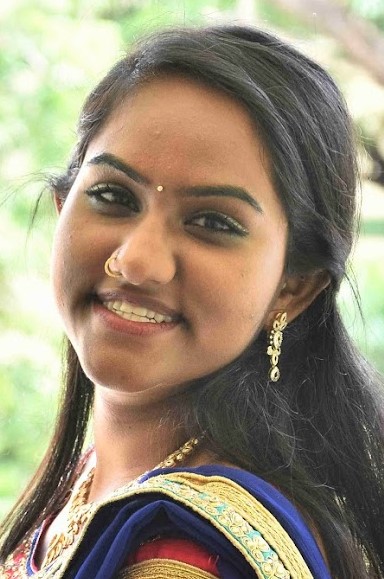 a passionate advocate for mental health, particularly within the South Asian community. She aspires to combine her knowledge of neuroscience with public health to provide more equitable access to healthcare for individuals with mental health problems. She is dedicated to preserving her Indian cultural roots through activities on and off campus. Currently, she is the Co-Director for Bhangra in the Burgh 12, a nonprofit Bhangra competition hosted by Carnegie Mellon and Pitt students to raise money for the Creative and Expressive Arts Therapy program at the Children’s Hospital of Pittsburgh.
a passionate advocate for mental health, particularly within the South Asian community. She aspires to combine her knowledge of neuroscience with public health to provide more equitable access to healthcare for individuals with mental health problems. She is dedicated to preserving her Indian cultural roots through activities on and off campus. Currently, she is the Co-Director for Bhangra in the Burgh 12, a nonprofit Bhangra competition hosted by Carnegie Mellon and Pitt students to raise money for the Creative and Expressive Arts Therapy program at the Children’s Hospital of Pittsburgh.
The World Health Organization’s recent report says that by 2020, depression will be the 2nd leading cause of disease; by 2030, it is set to outpace heart disease as the #1 cause of disease worldwide. An estimated 97.5 million people are suffering from mental illnesses in India alone. The incidence of depression is about one in every twenty Indians — roughly 5% of the country’s population. And it’s only getting worse. Chidren of our Bharat Maata is suffering from a serious mental health crisis.
Why is the birthplace of yoga, meditation, and mindfulness also home to about half of the global mental illness disease burden? And why hasn’t it shown signs of stopping?
The answer is simple – our attitude. We fear sharing our feelings with others. We judge and fear judgement towards individuals with mental illness. But most importantly, we fear ourselves, and fear admitting that we may actually need some help, after all. All of this fear contributes to strengthening the stigma, forcing us further and farther away from what we really need—direct confrontation. However, we’re a long way from tackling this issue face-to-face.
According to the Live Love Laugh Foundation, in a survey of 3,556 respondents from eight cities across IAndia, 47% could be categorized as being highly judgmental of people perceived as having a mental illness. Of the 47%, respondents were more likely to say that one should keep a safe distance from those who are depressed, or that interacting with a mentally ill person could affect the mental health of others. And the worst part – 26% were categorized as being afraid of the mentally ill.
But are we afraid of people with diabetes? Or hypertension? Why should we view mental illness any differently?
Like any other chronic illness, mental illnesses have both a behavioral and a physiological component. The only difference here is that instead of focusing on the heart or pancreas as in the case of heart problems and diabetes, the area of interest in mental illness is the brain.
In the mental health issues among Indians, when does it all stop? When does the fear stop and the courage begin? When do we stop being afraid and start being brave enough to confront our inner demons? How do we stop taking step backwards and start to move forward in our fight against this disease?
I offer somewhat of a trivial solution: let’s change the way we view mental illness and begin to treat it as a worldwide epidemic. The formal definition of an epidemic is the widespread occurrence of an infectious disease in a community at a given time. That is precisely what mental illness is – it’s a widespread, infectious disease, plaguing not just one community, but hundreds of thousands across the globe, right now!
The WHO suggests that reversing epidemics, is a 3 step process:
- Interrupt transmission
- Prevent future spread
- Change group norms
Thankfully, when it comes to mental health, we don’t have to do all these 3 things – we only have to do one; we must change group norms. But just how do we go about changing group norms?
They say that the hardest thing to do when it comes to treating a mental illness is acceptance – by the individual. But it’s bigger than that; it has to do with group [or socia]) acceptance acceptance.
In the Bhagavad Gita, Krishna declares, “The man who sees me in everything and everything in me will not be lost to me, nor will I ever be lost to him. When he sees all beings as equal in suffering or in joy because they are like himself, that man has grown perfect in yoga.â€
We must look not only look beyond ourselves, but also within ourselves. Group norms aren’t something that just change overnight. They begin with the individual. Changing the way we view ourselves will allow us to see what Krishna preaches in the Gita — we will begin to see others as being equal in suffering.
So next time you’re feeling a little down, or you hear about or see someone struggling with symptoms of mental illness, take a minute and set all the judgements aside. Rather than being afraid of yourself or that person, be brave enough to give your love and compassion. Rather than offering pity, offer support. Rather than shying away from the conversation, become an advocate. Together, we can change group norms and beat the worldwide epidemic that’s shamelessly claiming the minds of many. All we have to do is speak up and inspire others to do the same.   ♠
Home:
Dr. Swami Nathan Receives Life-Time Achievement Award in Psychiatry
Posted by admin in October 2018, Past issues on November 18, 2018
(Paul) G. Manoharan, Upper St Claire, PA
e-mail:Â gopalsamy.manoharan@stifel.com
On September 24, 2018, the Pittsburgh Psychiatric Society presented the “Lifetime Achievement Award for Academic Psychiatry†to Dr. Swami Nathan, MD, DLFAPA, to honor “outstanding contributions and devotion to academic psychiatry and to the Pittsburgh Psychiatric Organization.â€Â  All of his friends in the
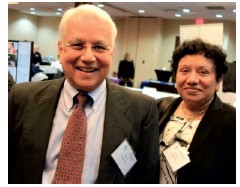
Dr. Swami Nathan and his wife Girija
Pittsburgh area who have known Dr. Nathan’s accomplishments for many years were gratified to see this richly deserved honor bestowed on him by his professional peers. True to his characteristic humility, Dr. Nathan credits his several mentors he was fortunate to have had in his life.
For the Pittsburgh Indian community for a long time, Dr. Nathan has been the “Go To†psychiatrist during times of distress and misfortune. He was always there to guide through difficult transitions with his expertise and appreciation of the difficulties with our unique cultural differences. For several years, Dr. Nathan worked with children in the Temple youth camps and was very popular with children for his understanding of their concerns.
Dr. Nathan came to the US in 1973, armed with a medical degree from the Stanley Medical College of the University of Madras and accompanied by his new bride, Dr. Girija, his heart throb in college, to start his residency in psychiatry in New York, followed by his fellowship at New York State Psychiatric Institute and Columbia University. He was an Assistant Professor of Clinical Psychiatry at Columbia until 1980.
Dr. Nathan came to Pittsburgh in 1980 to be an Assistant Professor of Psychiatry at the University School of Medicine and Western Psychiatric Institute and Clinic and served as a Medical Director at Western Psych. He then moved to Allegheny General Hospital to become Vice Chairman, Department of Psychiatry and Professor of Psychiatry at the Medical College of Pennsylvania and Hahnemann University. Currently, Dr. Nathan is retired and enjoying a life of leisure with his wife Girija and nurturing their two lovely grandchildren.
For his many friends in Pittsburgh, Dr. Nathan is a warm friend with a helping hand, a good sense of humor and an ever-present positive outlook. May God Bless the Nathans.  ♠

